 BjoernM21
122
BjoernM21
122

Paul Gerber: Amateur Watchmaking with the Master
Sep 20, 2018,01:05 AM
“Initiation Courses” have become very popular within
the watch industry. Almost every manufactory visit is interrupted by a workshop
to give visitors the illusion of being watchmakers. With me, this illusion
vanished quickly, even when dressed in a white watchmaker’s coat, because
taking apart a movement and reassembling it was only proof of my challenged
fine motor skills. For my part, I thus declared these entertainments as a waste
of valuable visiting time after two experiences.
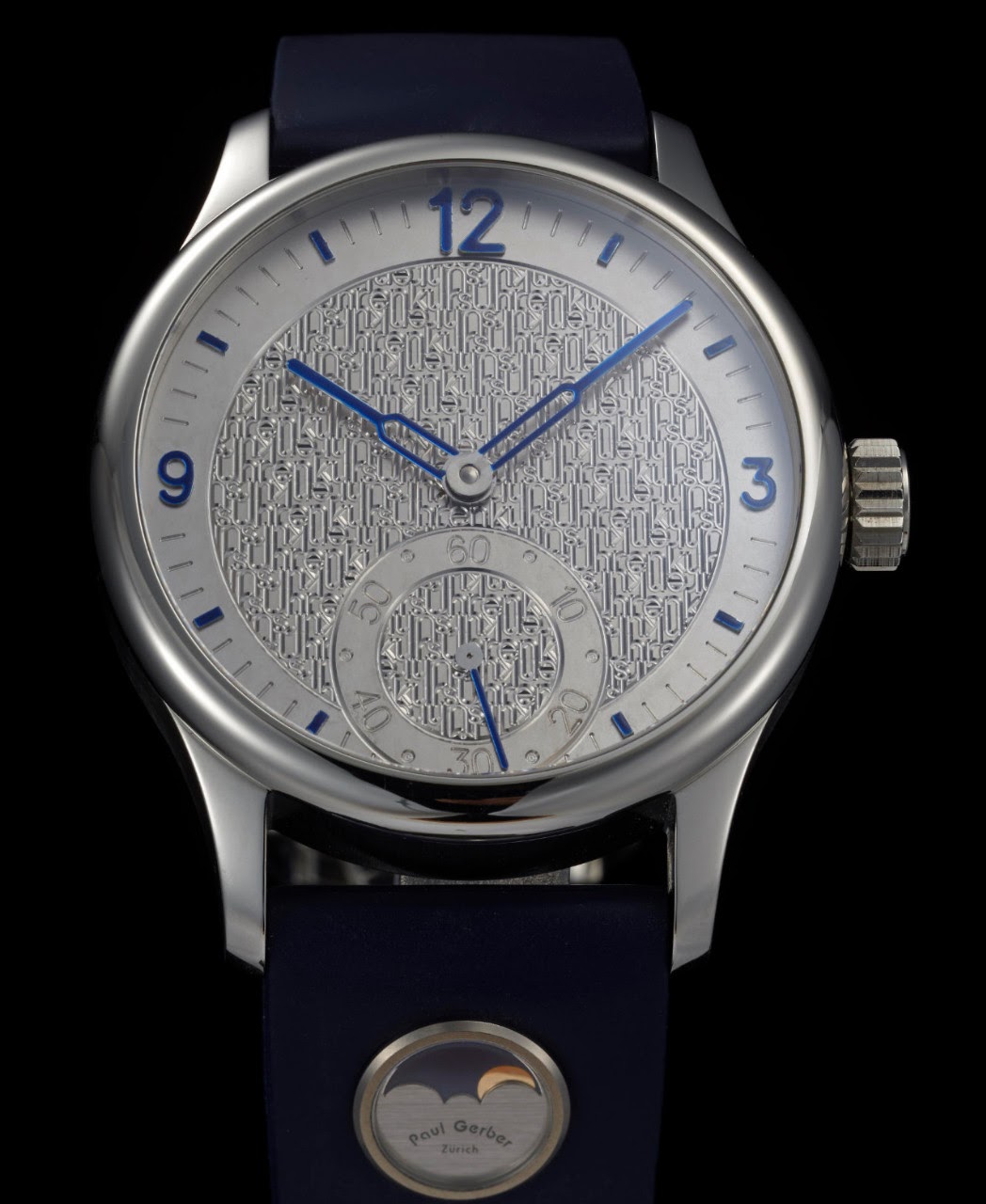
Below: (LH) A “Masterclass” at Jaeger-LeCoultre as part of a watch magazine reader’s manufactory
visit (Photo: Watchtime.net); (RH) these “Masterclasses” are also offered
outside the manufactory, to support events of local dealers (Photo: luxify.de).

Below: When A. Lange & Söhne
was sending me a form to apply for a “VIP-Akademie”
course staged in Switzerland, all was forgotten and I sent off my wish to take
one of the eight places. I did not qualify. But reading a report about such an
event on another blog, I got the feeling not to have missed a lot. ALS offers the
participants at these events (called outside Switzerland “Connoisseur’s Akademie”) the opportunity to try their own hands at
decoration work on the movement (engraving a balance cock, polishing etc.),
including disassembling and refitting an Unitas/ETA
6498 wheel train (with no escapement or balance wheel installed). The problem
with these offers seems to be the time restraints, with two days not sufficient
to do more. (Photo: A. Lange & Söhne)
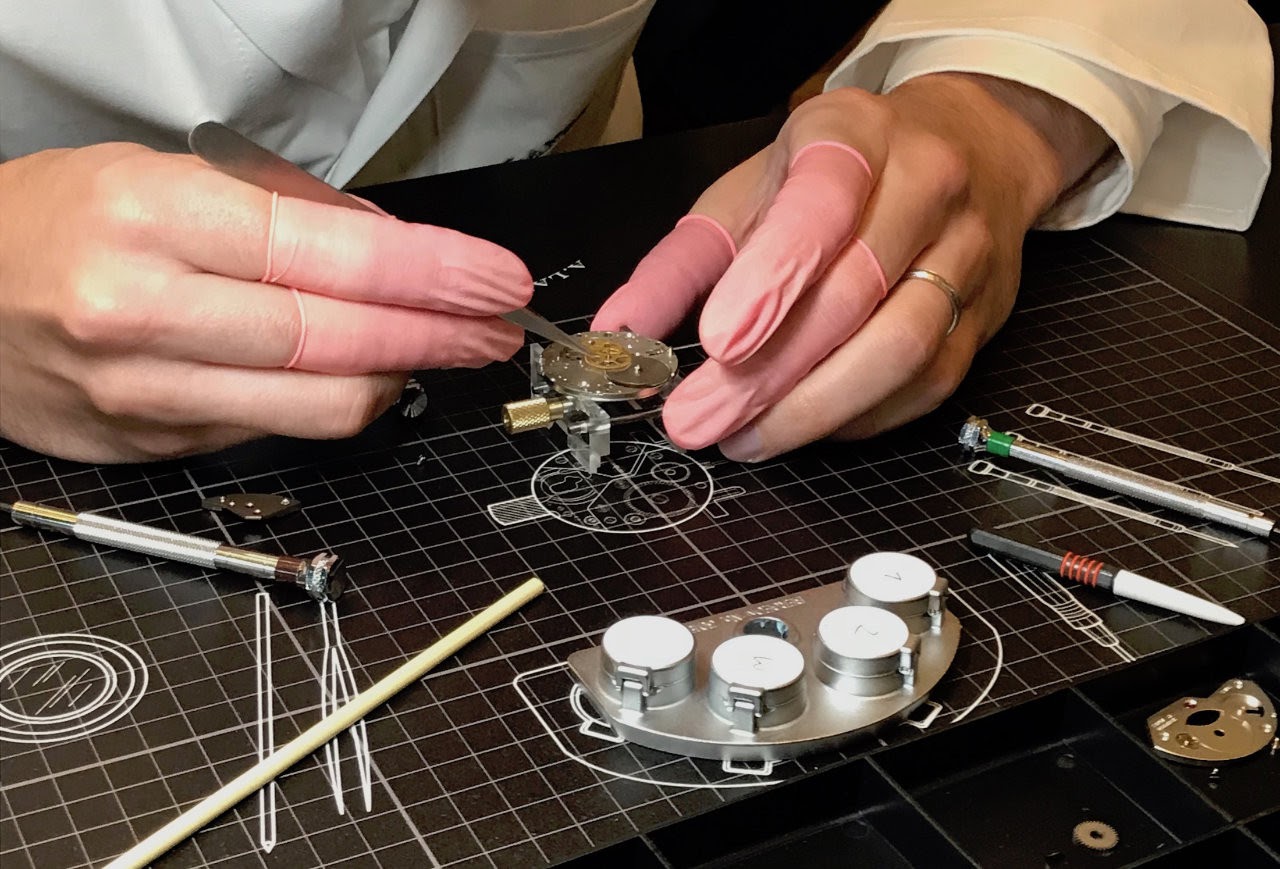
Below: The time spent on the watch is even further
reduced at the events promoted by the Tourism Office of Neuchâtel/Le Locle (and many others in the Jura region). Within three or
four hours the participants of these “courses” assemble their own watch.
Looking at the extensive choices for case, hands, straps etc., it sounds to me
a bit like the experience provided by Ikea to its customers. Within this
timeframe it is simply not possible to treat respectively refine movement parts.
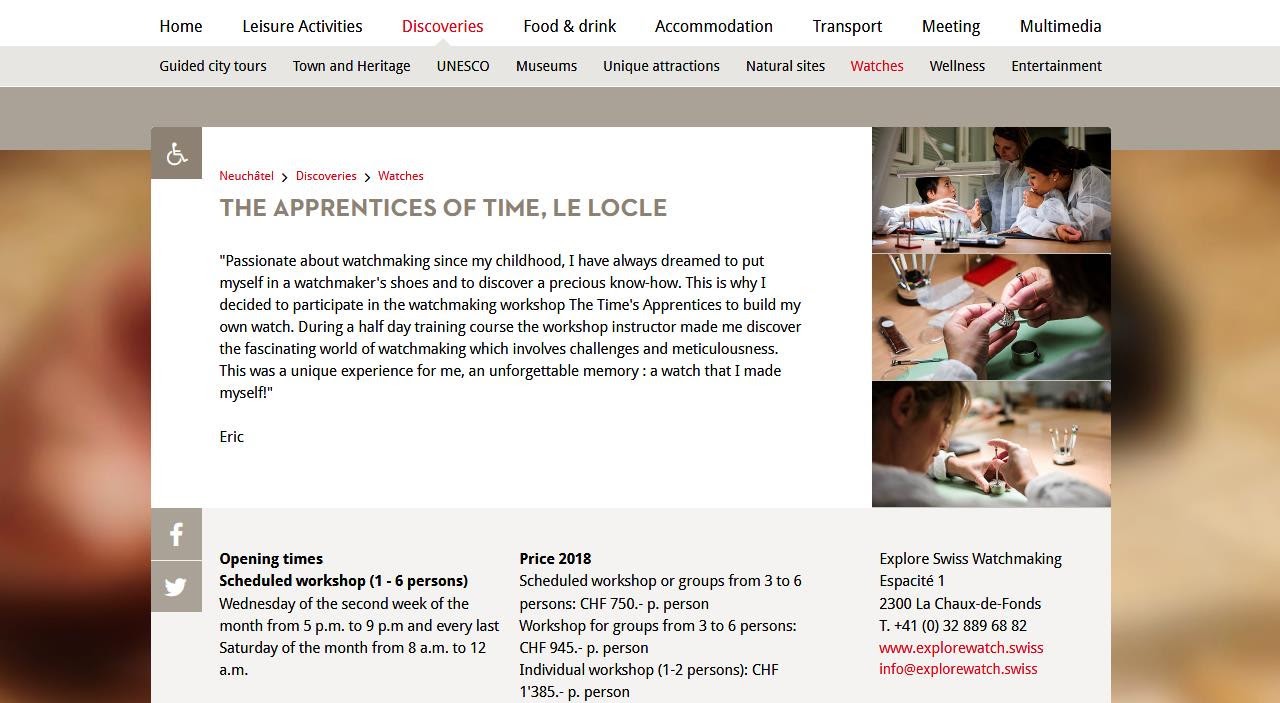
Below: The participants are involved on a different
level in the courses offered by various watchmakers in Germany since many
years. I attended a two-day course with Lottermann
& Söhne in Mannheim in 2008. Looking at their
website, the program seems to be still the same nowadays, only the Molnija 3603 calibre we had replaced by an ETA 6498.

With quite a few theory lectures embedded in these
instructions, the two days were also not sufficient to include anglage of the bridges and other detail work. Though, we
polished and flame blued the screws, we ground the bridges and put the Geneva
stripes on, and decorated crown and ratchet wheels. The bridges got their final
galvanic gold plating applied by the participants too.
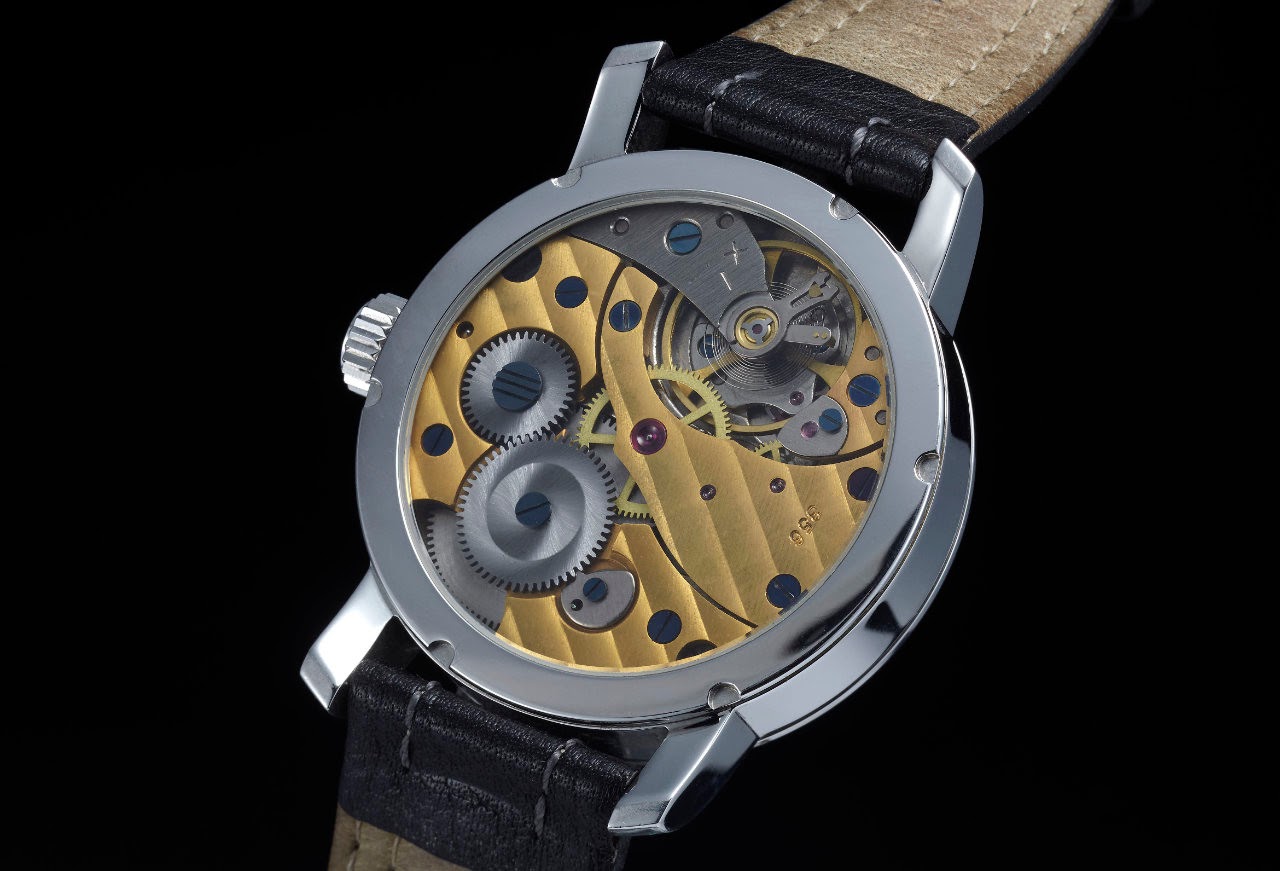
These courses are run by Tim Lottermann
and master watchmaker Franz Wolff, and they are now also staged in London and
Den Haag. Part of their offer are much more demanding courses, like learning to
convert a movement into a regulator display, or even building a pendulum clock
based on plans (running on four to six weekends for one year).
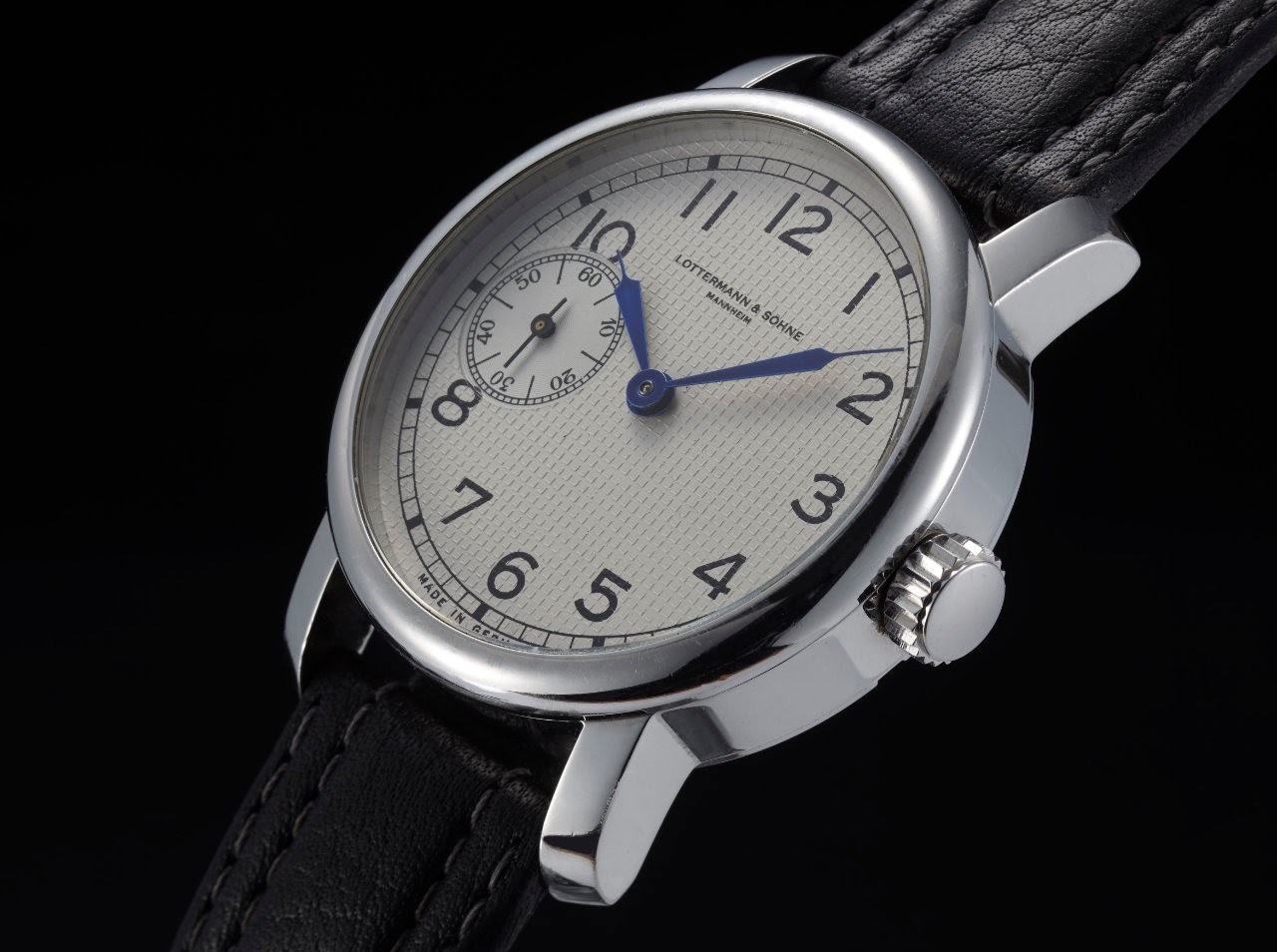
My work must have been a bit shoddy, because the watch
stopped running early in its duty as a daily beater. Nevertheless, I had
enjoyed the experience and wanted to repeat it. The dream was to get under the
tutelage of master watchmaker Paul Gerber.
In spring 2018 I finally manged to get a place in one
of the workshops offered in Zurich/Switzerland. He runs only about three of these
3-day-workshops per year for three pupils at a time. So waiting times are about
equal to delivery time of a Rolex GMT Pepsi…
Tim Jackson, representing many independent master
watchmakers in California, combined Baselworld 2013
with a visit to Paul Gerber’s atelier in Zurich. Tim’s introduction of him
(Blog, 30 April 2013) says it all: “When one gets to visit one of the greatest
unsung heroes in the Independent Watchmaking world, the humble and brilliant
Paul Gerber, in his place of creativity, great things open up. I have been
working with Paul 2 years now and have come to realise that his depth of
horological knowledge is far and wide. What I didn’t realize was how much he
has been beavering away behind the scenes as an Independent Watchmaker for the
big brands, as the go to guy.”
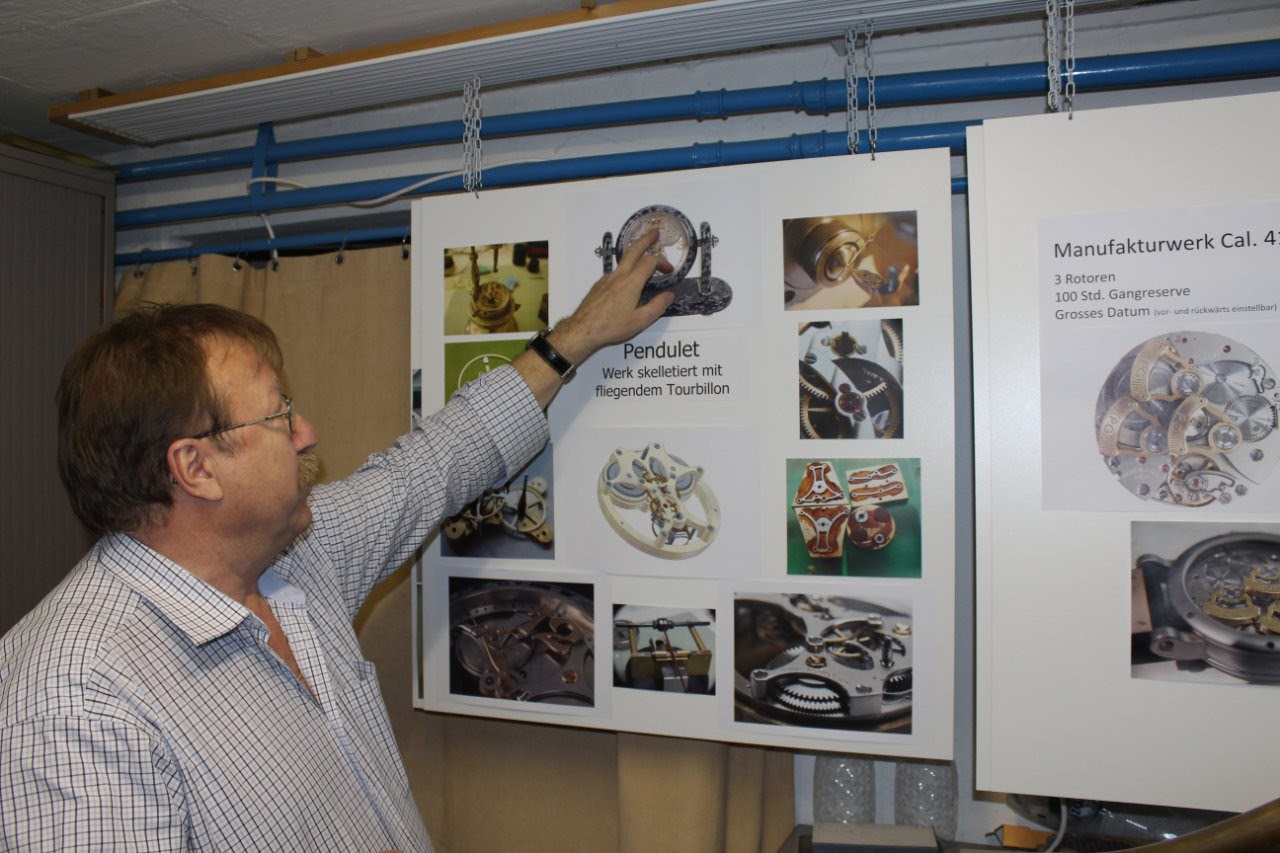
To enthusiasts visiting his atelier, Paul Gerber
introduces himself with a manually operated “Power Point” device hung to the
ceiling of the former garage in the basement of his house. Due to the secrecy
agreements with the industry customers, only very few of the 53 movements
developed (so far) in his career can be discussed and shown. Paul Gerber has
chosen a similar career path to Andreas Strehler, i.e. offering watches with
his own name on the dial almost only as a side line to generating the main
income with development work and production for third parties (who then
highlight their in-house engineering competence based on the results…). Having
reached the official retirement age, he decided to work henceforth without
employees and concentrate on projects he has a personal interest in. Being
together with Paul Gerber for three days, I gathered how difficult it must be
to work as an un-named master for the watch industry. A “humble” demeanour does
not mean the watchmaker would not appreciate to be properly recognised for his
work.
Paul Gerber is a soft-spoken man, what makes it
difficult to even slightly grasp his watchmaking genius as a layman. Presenting
one of his technical solutions, he uses a few words in a matter of fact style,
giving the impression everybody is doing it this way. Only when you start
prodding it becomes obvious why many big brands consult him to overcome
problems they stumbled upon in some movement development work. To better
understand technical matters, I like to compare with solutions I know already. Trying
to refer to other’s work leads to the introduction “One should not criticize
the work of others,…”, before Paul Gerber explains his
solution.
I looked very much forward to the three days in Paul
Gerber’s atelier, to the work we pupils are doing and to have an opportunity to
learn more about the master and his work en passant.
I was not disappointed in this expectation, but in this post a few samples of
his work have to do.
Constructor
of the World’s Most Complicated Wristwatch
Paul Gerber is perhaps best known on this forum for
one watch he is involved with intensively since 1992: The “Most Complicated Wristwatch
of the World”. Originally it was the project of forum member “Lord Arran”. He
sold it soon after gaining the sought-after accolades (presentation show at the
MIH in 2003; Guinness Book of World Records entry in 2005). The new owner Ralph
Graf had it only now finished and properly detailed, as well as giving it a
name (“Superbia Humanitatis”)
and other symbols of appreciation, including its own book written by Magnus Bosse. As long time chronicler of this watch, Magnus has
presented its history on another blog ( https://bit.ly/2OlwRNw ), and corrected who
had actually done the work to create the status of the watch, despite another
name on the dial.
Intensively creating a watch with a private customer
brings an “attachment” of the master to the watch with it when he gave his all
to realise what the customer presented as his dream. To experience how the
customer cherishes and enjoys the finished watch for years means a lot to Paul
Gerber and brings satisfaction to him, making all the efforts worthwhile. To
learn this from someone with a very “matter-of-fact”-communication style like
Paul Gerber, opened a bit my eyes: Having commissioned a watch, we should
perhaps really show from time to time how we enjoy it and not having degraded
it to a “safe queen”.
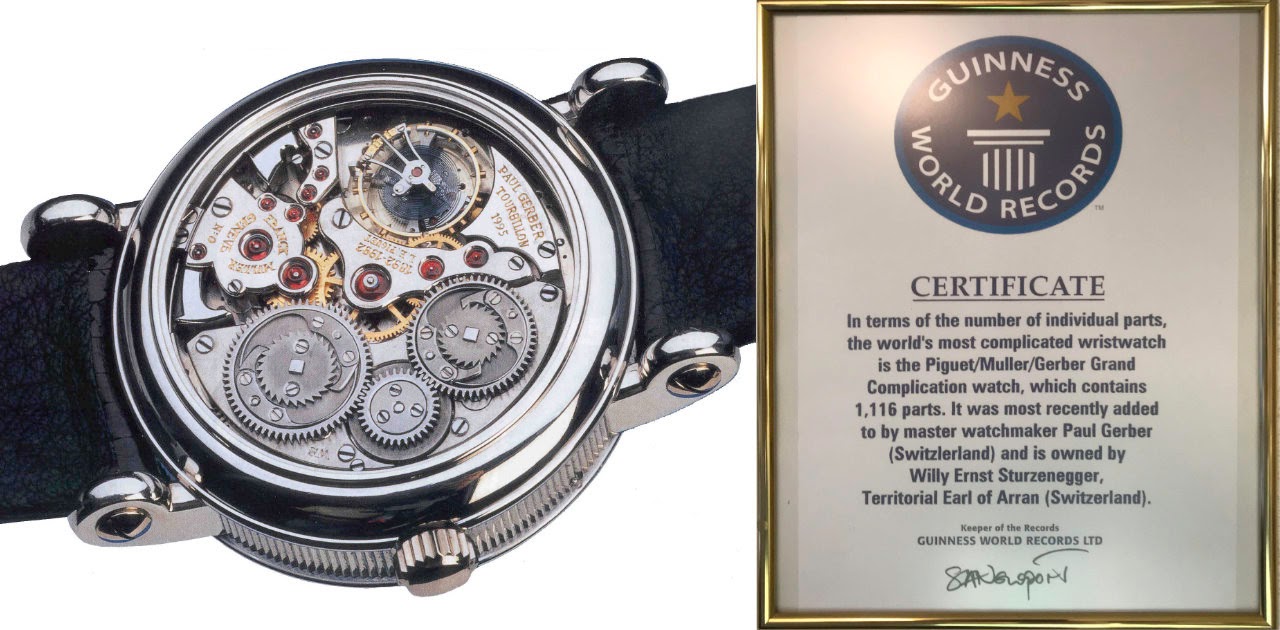
The Love for
Wood
Another surprise was to learn wood to be a favoured
material of Paul Gerber. Not only was our attention drawn to the window boards
in the atelier he had made himself from plum wood, but I got also the
impression he is most proud about his wood turning skills. When we discussed
this wood work in a coffee break, he went away to come back with a superbly
formed cowboy hat entirely made from one piece of wood. His turning skills must
indeed be on the highest level, because the wood of the hat was so thin the light
showed through bright and even. We course participants could experience this
hobby with tools (particularly files) fitted with wooden grips turned by the
master himself.
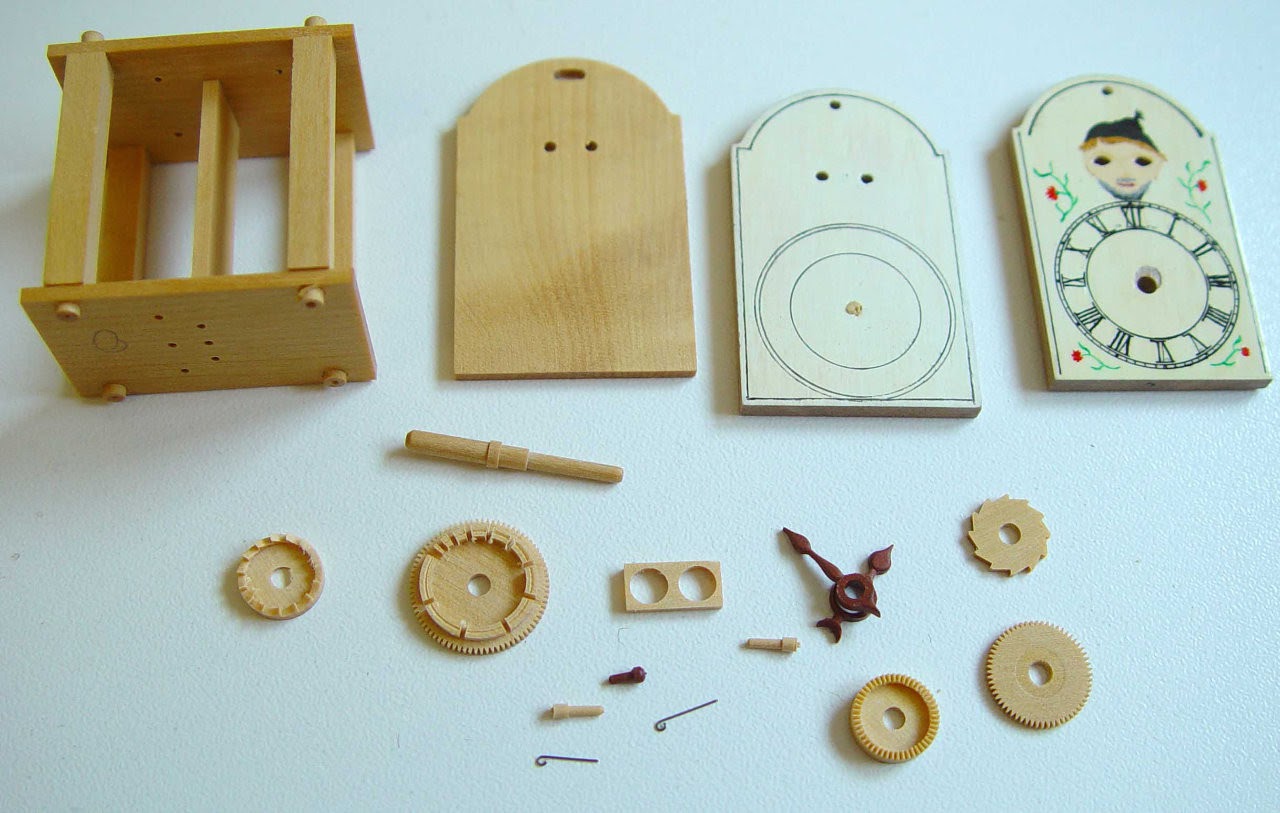
Paul Gerber started his career as watch constructor
with a particular interest in the miniaturisation of mechanics in wood. While
running a watch retail and restoration business for a living, the spare time
was spent building wall clocks in the size of a matchbox entirely from boxwood,
the style inspired by the Black Forest clocks. No screws were used, only wooden
pegs. He not only gained 1989 an entry in the Guinness book of records for the
smallest functioning wooden-wheeled clock, but even found buyers for them at
the annual watch show in Vincenza/Italy. While the
retail dealers ordering at this show in the late 1980s had no interest, their
female companions were early “influencers” and wanted to have one of these
oh-so-cute clocks. When Paul Gerber started to add complications (moon phase,
equation of time etc.), he realised quickly that the typical buyer did not
understand these additions, and “cuteness” as the only appreciated USP was no basis
to get a decent remuneration for the time invested. At least these miniature
clocks worked as his calling card to be invited to join the AHCI.

In-House
Movements
Paul Gerber, who constructed the movements from the
beginning in CAD, was soon discovered by the watch industry. Only very few
allowed him to make his involvement public, for example, Fortis hired him in
1996 to integrate an alarm mechanism into a Valjoux
7750 movement to help with the revival of the brand as a competent player for
interesting mechanical watches.
His own wristwatch model range was started in 1997
with retrograde displays on the basis of a Peseux
7001 movement (“Retro Twin” and “Retrograd”).
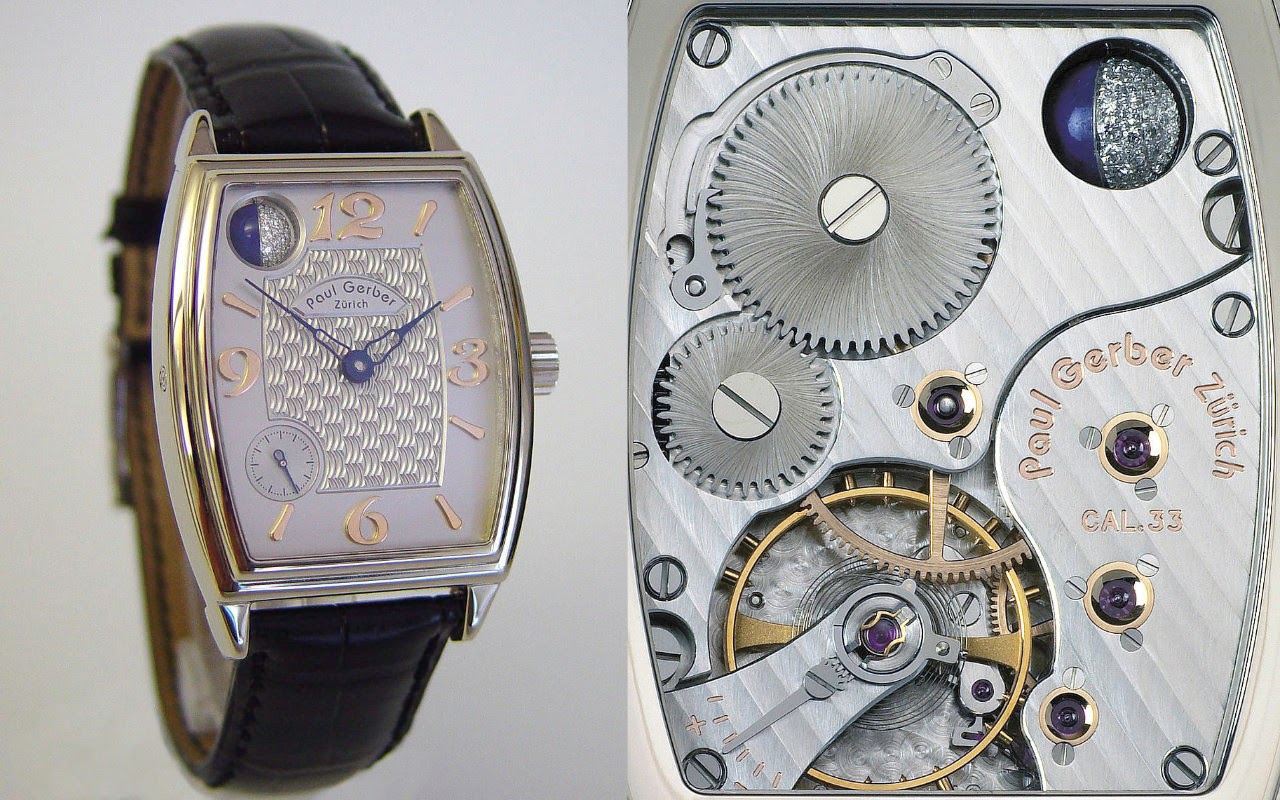
Above: I am particularly attracted to the entirely
in-house made form movement calibre 33 presented by Paul Gerber in 2005. The
movement is offered in different versions with a tonneau-shaped
case.
Below: Paul Gerber was the first to integrate a 3D-moon
phase display into a wristwatch (a 6 mm diameter sphere). Reference 33 got also
his own escapement, avoiding compressing forces in action (Patent EP1517197).

Below: Paul Gerber, he likes the Reference 41 (also
with an in-house calibre) more. Asked why, I learnt that the Reference 33 made
in precious metals degenerates too easily into a safe queen with its owners.
This saddens him, because he wants his customers to enjoy the watches in daily
life. The sporty Reference 41 is usually enjoyed this way, though, technical
specialities are also found here: manufacture automatic movement (100 hours
power reserve), three gold rotors (Patent EP1136891), large quick-set date, and
seconds being shown continuously or jumping (Patent EP2098921).
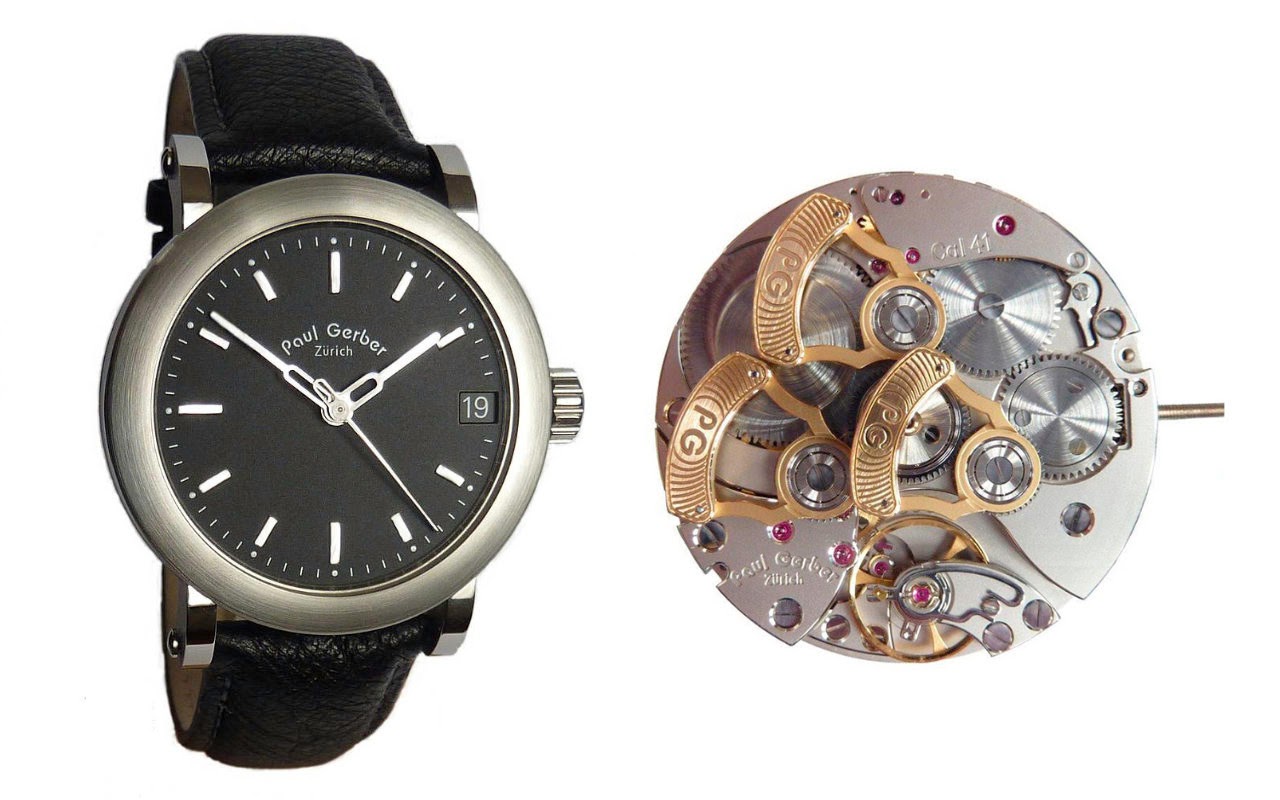
Below: Paul Gerber constructed and built the one-minute
flying tourbillon table clocks for Audemars Piguet. The version bearing his own
name is still available. Earlier he used a full dial (LH); later he preferred the
skeletonized version (RH) showing more of the movement construction.
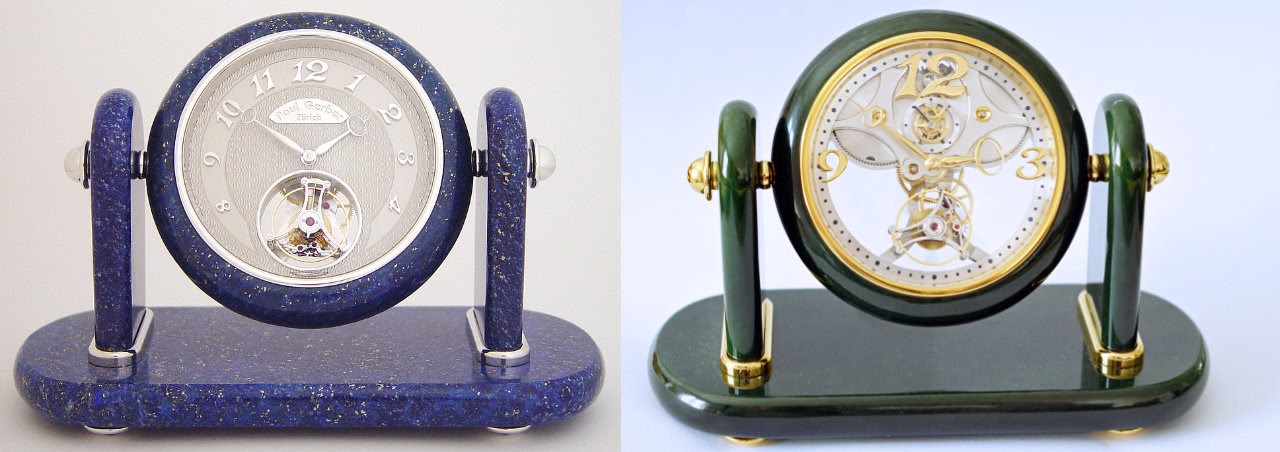
Below: The concept Ludwig Oechslin
developed for the MIH watch was converted to reality by Paul Gerber (he built
the prototypes as well as the series watches). And the final configuration is
the result of diplomatic “guiding” by Paul Gerber: Ludwig Oechslin’s
concept based on the ETA 2892, which Paul Gerber deemed not strong enough for
the calendar functions; the proposed powerful Valjoux
7750 was first refused by Ludwig Oechslin because he
did not want a “sports” watch. When it became obvious that Ludwig Oechslin defines “sports” by two or more pushers, Paul
Gerber proposed converting the 7750 to one pusher! With a viewing hole integrated
into the back and a minute scale printed on a gear wheel, the owners have now the
calendar as well as a chronograph watch without looking like one. And Ludwig Oechslin was happy as well. (Photo RH below: Cazalea)
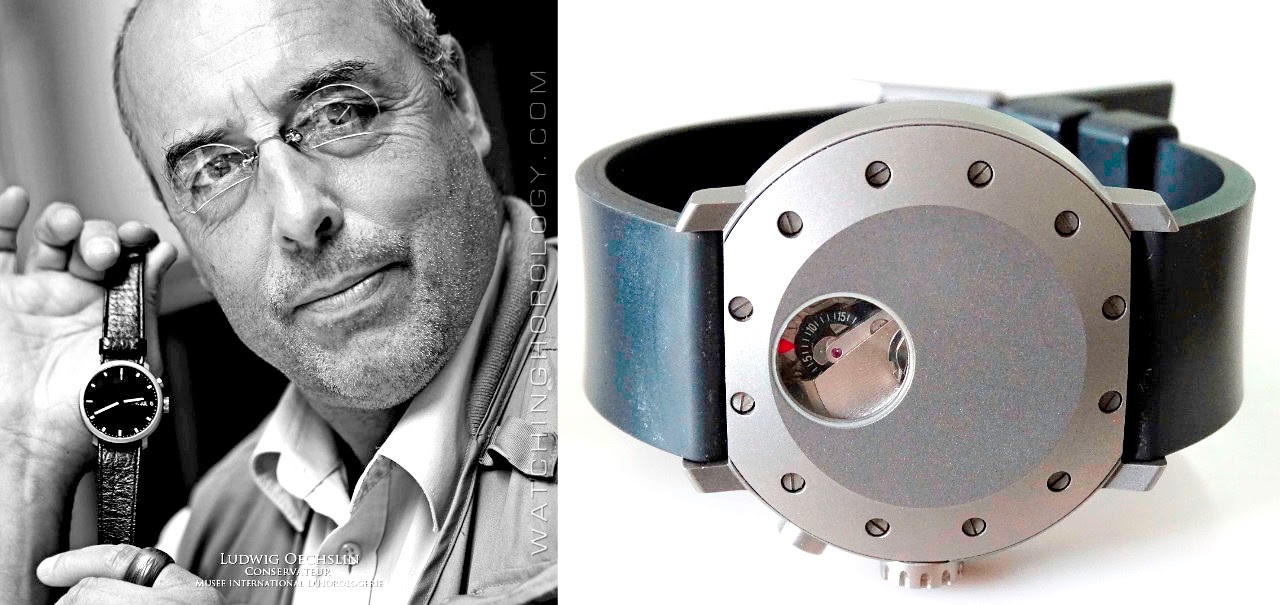
In 2007 Paul Geber was honoured with the Gaïa Prize in the craftsman-designer category. The laudatory
presentation was given by Magnus Bosse.
On this forum Magnus has regularly reported about
specific models, and two reports by AndrewD are also
worth (re-)reading:
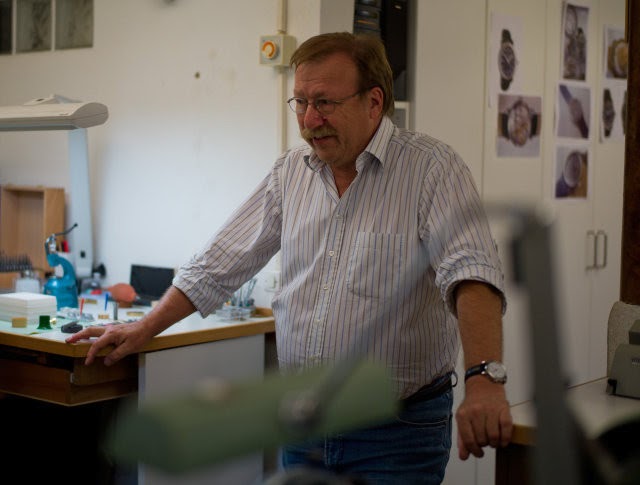
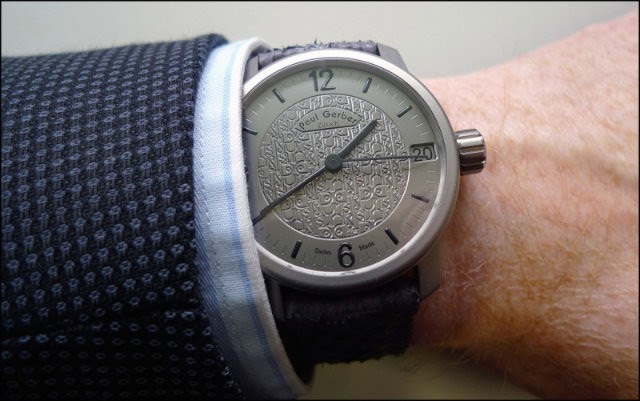
Review of 10th
Anniversary PuristS Wristwatch (Model 42) by AndrewD:
www.watchprosite.com
That a master of this standing takes it on him to
instruct amateurs just confirms what an easy-going, down-to-earth person Paul
Gerber has stayed. There is real love for watchmaking, which he enjoys to share
with all enthusiasts.
Building your
own watch with the Master
Paul and Ruth Gerber expect on the other hand commitment
brought to the course by the participants. To avoid an idle start of the
three-day-course, the meet-and-greet with Champagne and Canapés was staged on
the evening before the first working day.
Entering the atelier the next morning, I was right
away greeted with a sample of Paul Gerber’s love to give utilitarian parts a
touch of discreet decoration and style, like the custom made sewer cover in the
machining room.
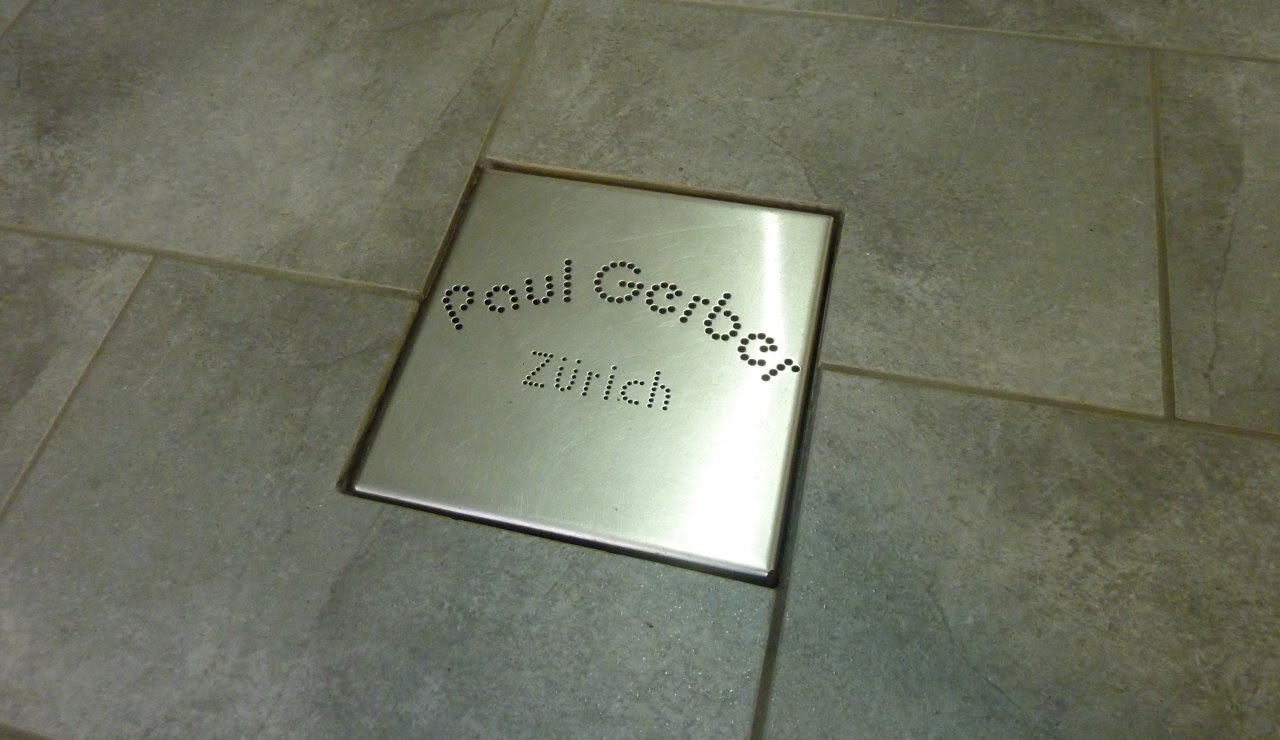
We three participants sat at the benches used before by
the employees of Paul Gerber (two to three usually). He has converted the
complete basement of his private house into a workshop and atelier. CNC mill, lathes and the blasting cabinet are installed in the
former garage. The toilet is also cleaning and galvanising department. The rest
of the floor is an open plan space with construction office, administration
office (Ruth Gerber’s job) and the watchmaker’s benches (with smaller machines
and work benches placed in between).
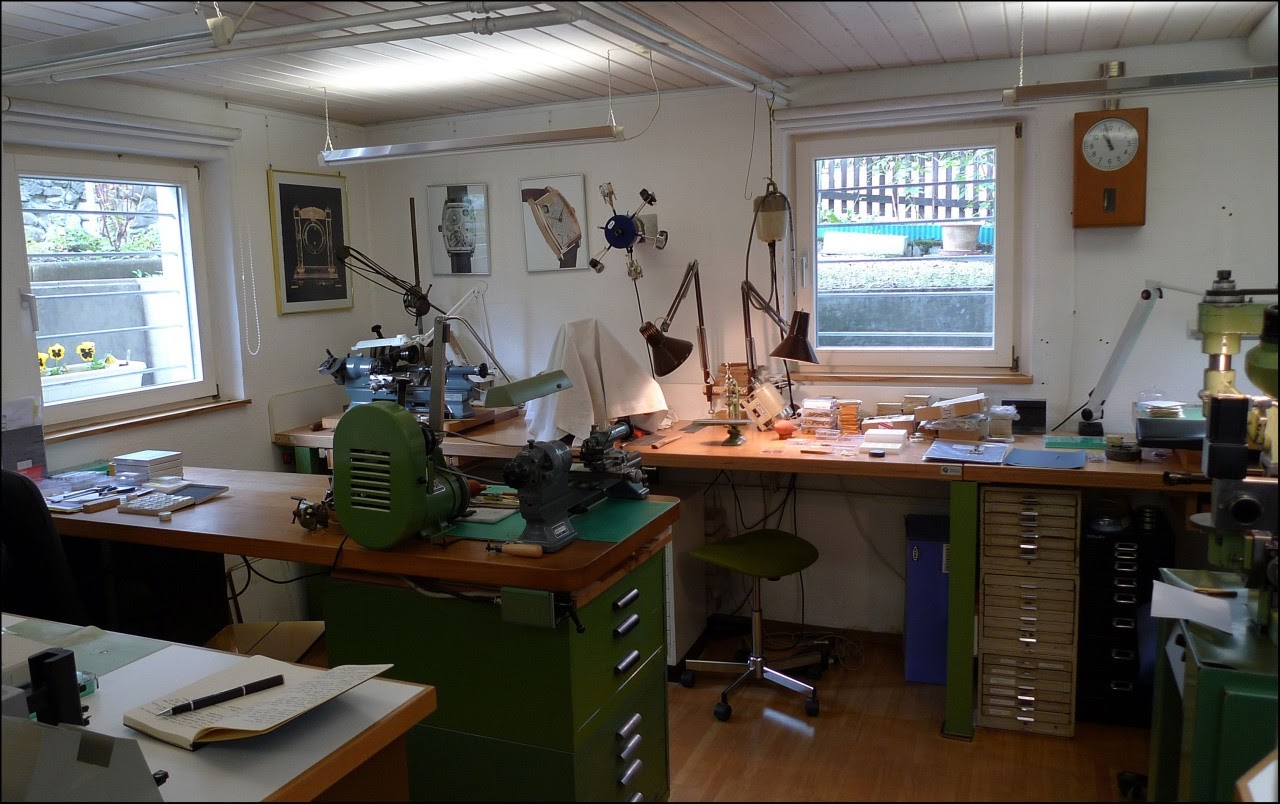
Paul Gerber uses the Unitas/ETA
6498 manual wind movement for the course. Its generous size with big screws and
the simple but classical construction give amateurs a chance to actually do
work on it, and the beefy parts survive clumsy handling better (including the
balance wheel). When professor at the Watchmaker’s School in Solothurn, he had
also introduced this movement (respectively the 6497 version) for the school
watch when the formerly used IWC 97 pocket watch calibre had become too
expensive for the pupils.
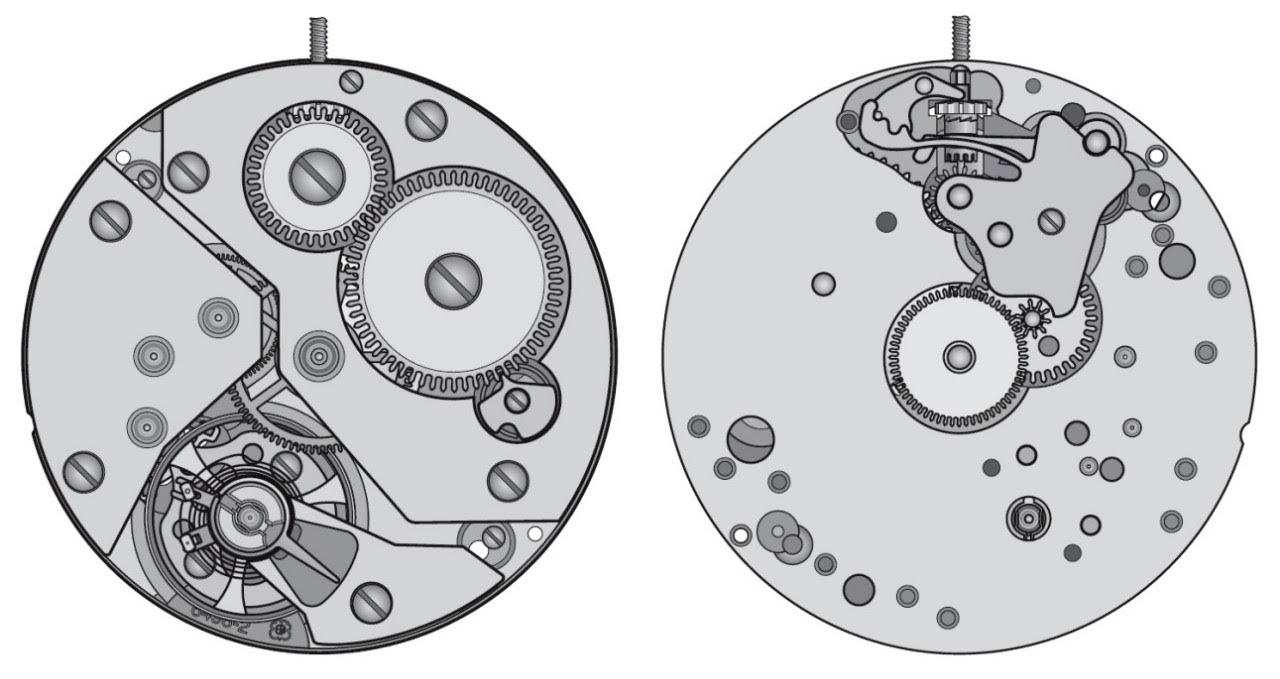
Sitting down at my bench and looking at the movement
with the nice Geneva striping, I wondered a bit how we can improve its look
with our work. Before we started with dismantling, the movement was timed on
the Witschi. Perhaps Paul Gerber wanted to get facts
to know where to point the finger afterwards if the final watch was running
substandard…
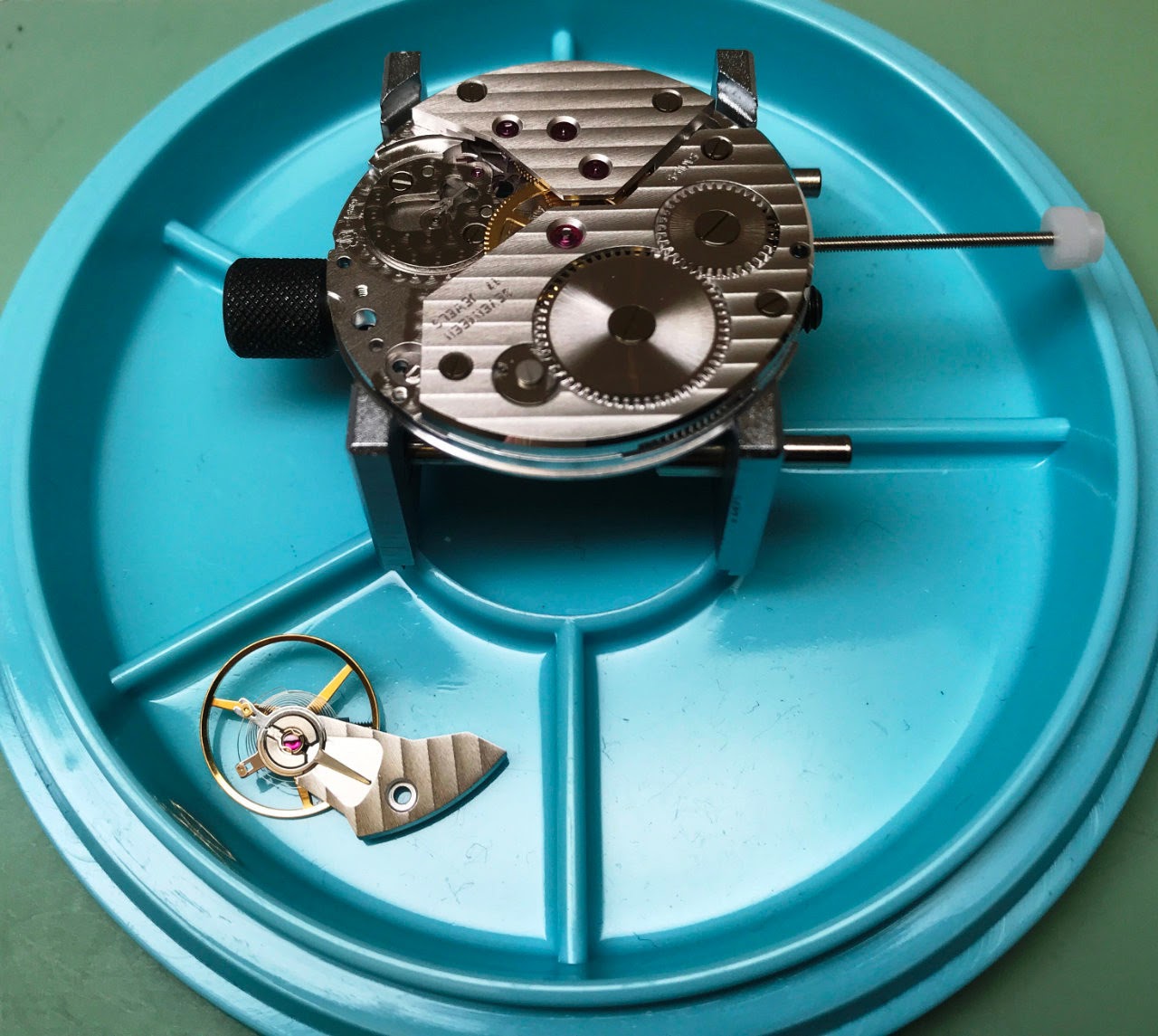
The goodies tray on the bench provided all the parts
Paul Gerber had produced to replace the ETA’s, plus the stainless steel case
manufactured by Fricker of Pforzheim/Germany. It is a
standard size from the industry catalogue, modified to accommodate the 0.5 mm
thick dial Paul Gerber uses.
The custom-made brass three-quarter bridge and balance
cock serve several purposes: First, they disguise the ETA movement a bit;
second, we got with them just the right amount of edges to work on, without
running out of time or getting bored by repetitive work; and finally, all the
parts later visible through the display back of the watch have also been worked
on by us pupils. These considerations reaffirm how Paul Gerber is not shying a
lot of additional work for the good of the course participants, even when we
would possibly not have realised how such improvements are possible and would
have been happy to work on the original ETA parts. Furthermore, he is even constantly
improving these in-house made parts from course to course when a good idea
comes up. “It will do” is just no argument for these independent masters used
to work on the top level!
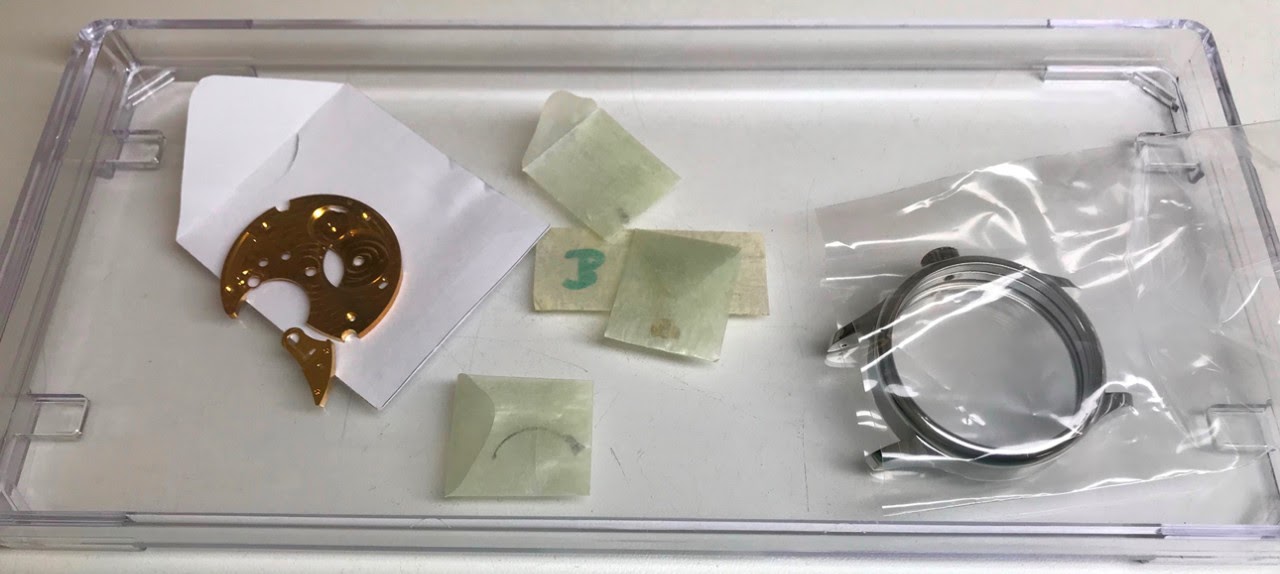
Above: Also in the tray is a prepared plaque with the
participant’s name to be screwed on the movement, plus a gold châton and a new click with its elegant spring, two further
modification of the ETA movement by Paul Gerber.
Below: In another tray the spring bars for the straps
and tools made in-house to ease working on the parts are provided.
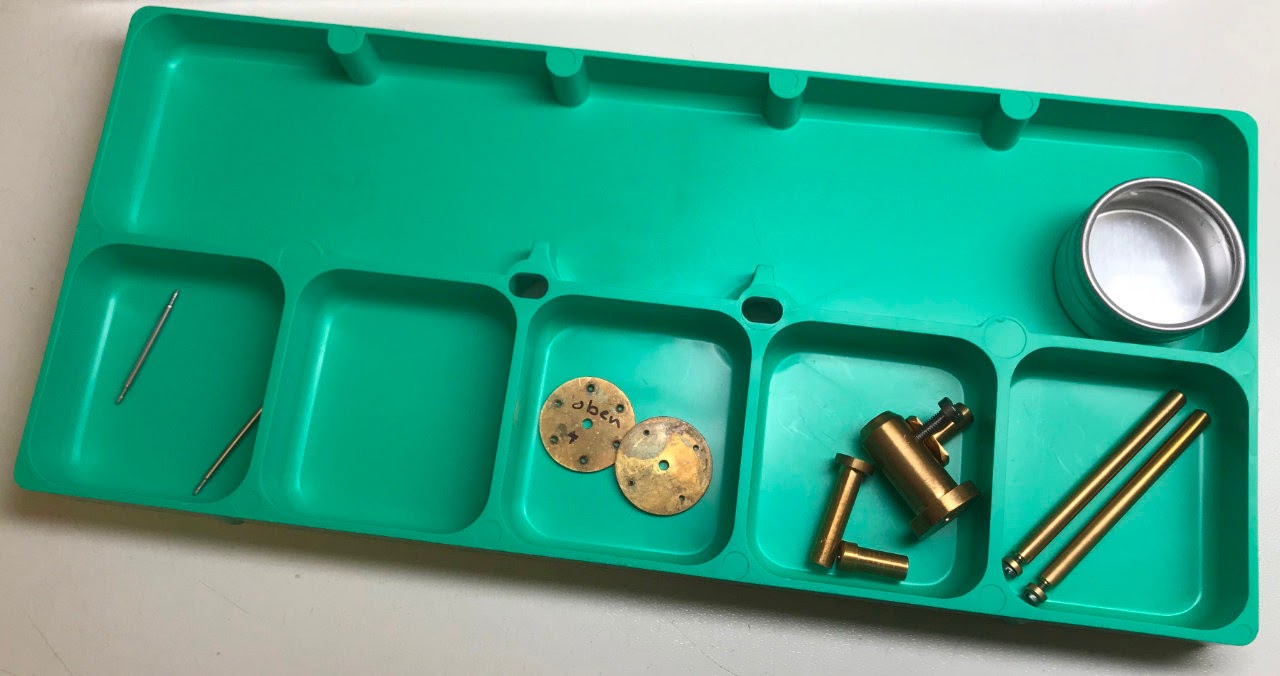
I very much liked the teaching method of Paul Geber:
There is not a lot of theory I would likely not have understood without the
part in question being elaborated at the same time; he rather builds a movement
in parallel with the pupils, so we could see the actual work being done for
each tiny step, and then immediately go to our bench and try it ourselves
before most advice is forgotten.
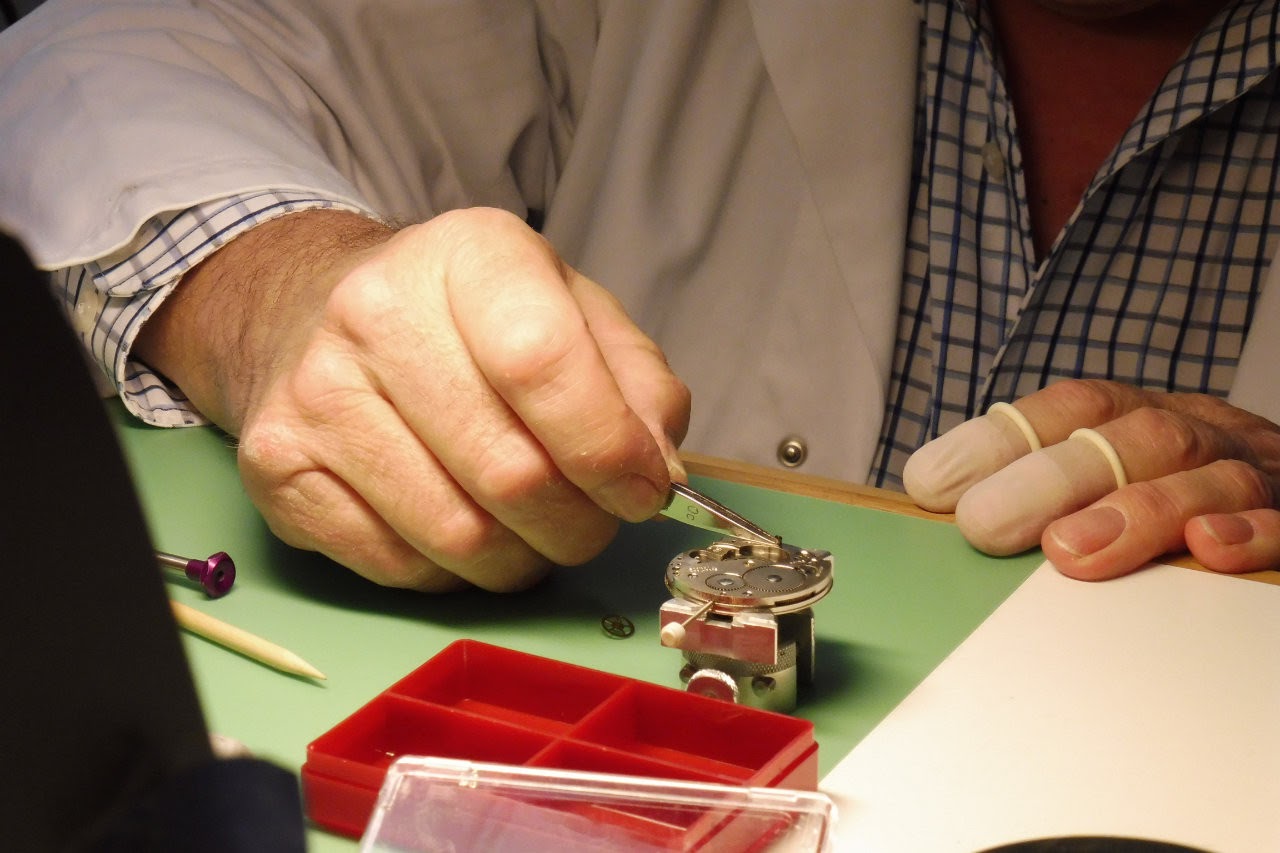
One instruction was to carefully unwind the yoke
spring (to avoid damage to it) in tiny steps by holding the click with a wooden
peg. I was glad that at this stage there was still enough back ground noise
with everybody settling down to disguise how I already failed in this first
task!

With all the movement parts separated, the real work
of three days could start. The three days were broken up with a free Sunday for
the participants. But work went on in the atelier, Paul Gerber preparing parts on
the Sunday he deemed amateurs could only ruin trying to do the work themselves (like
fixing the clicks absolutely even on the tool for polishing, fitting the ruby
bearing/shock protection system for the balance wheel etc.).
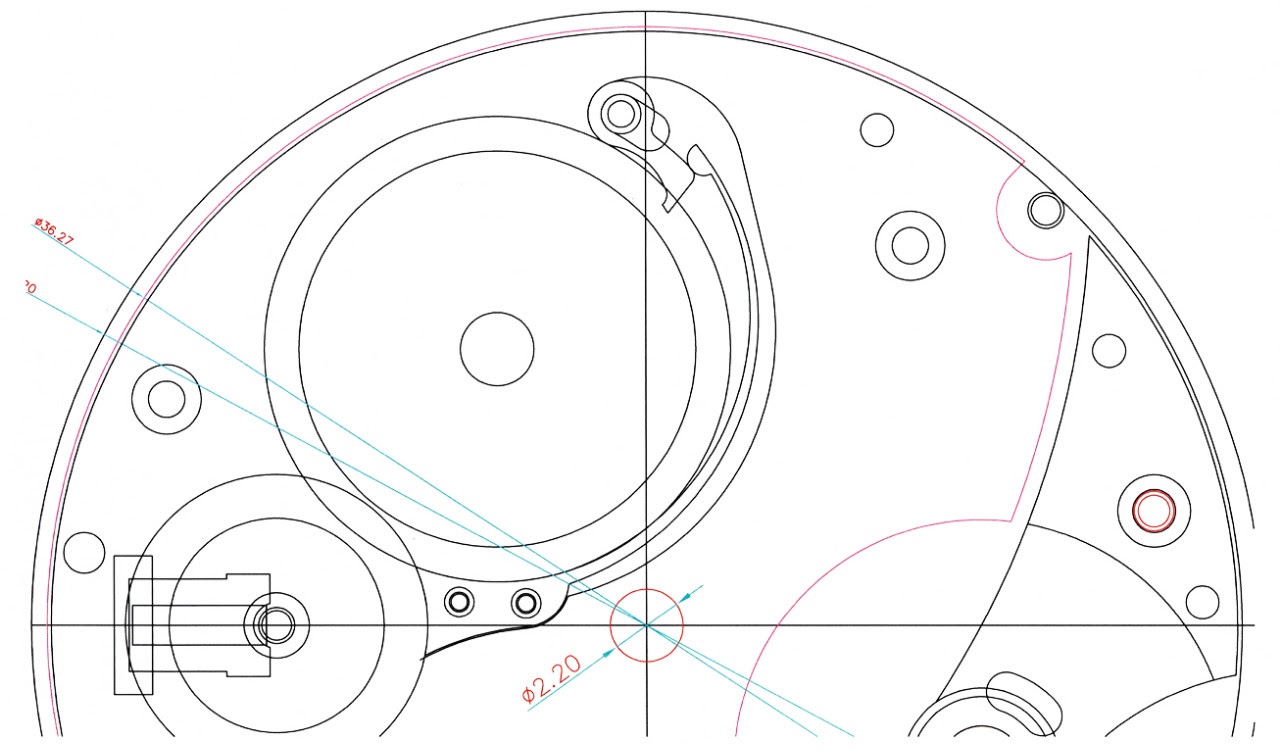
The custom made click with its spring is not only
there for the show. Paul Gerber took the inspiration for the elegant custom
made spring from the construction principle used in Glashütte
for quality watches (ETA uses a round click with the spring fitted right
underneath). Against the practice in Swiss watch building, the click is screwed
on from underneath for aesthetical reasons, not to show a big screw head in
plain view. The click is made moveable in a slot to ensure a precise and smooth
meshing with the teeth of the ratchet wheel (not the least because the winding
of the watch is not a continuous move, which leads to a slight turning back of
the ratchet wheel when the fingers have to re-grip the crown). To avoid side
loads on the screw, the recess in the bridge has to be milled very precisely to
ensure a perfect guiding and bracing of the click.
Learning about all these details made even an ETA
movement interesting. I also wondered once more, if the “In-house”-discussion
is not overrated, considering what a master watchmaker could all do with these
reliable and proven industry calibres (as also shown with the MIH watch).
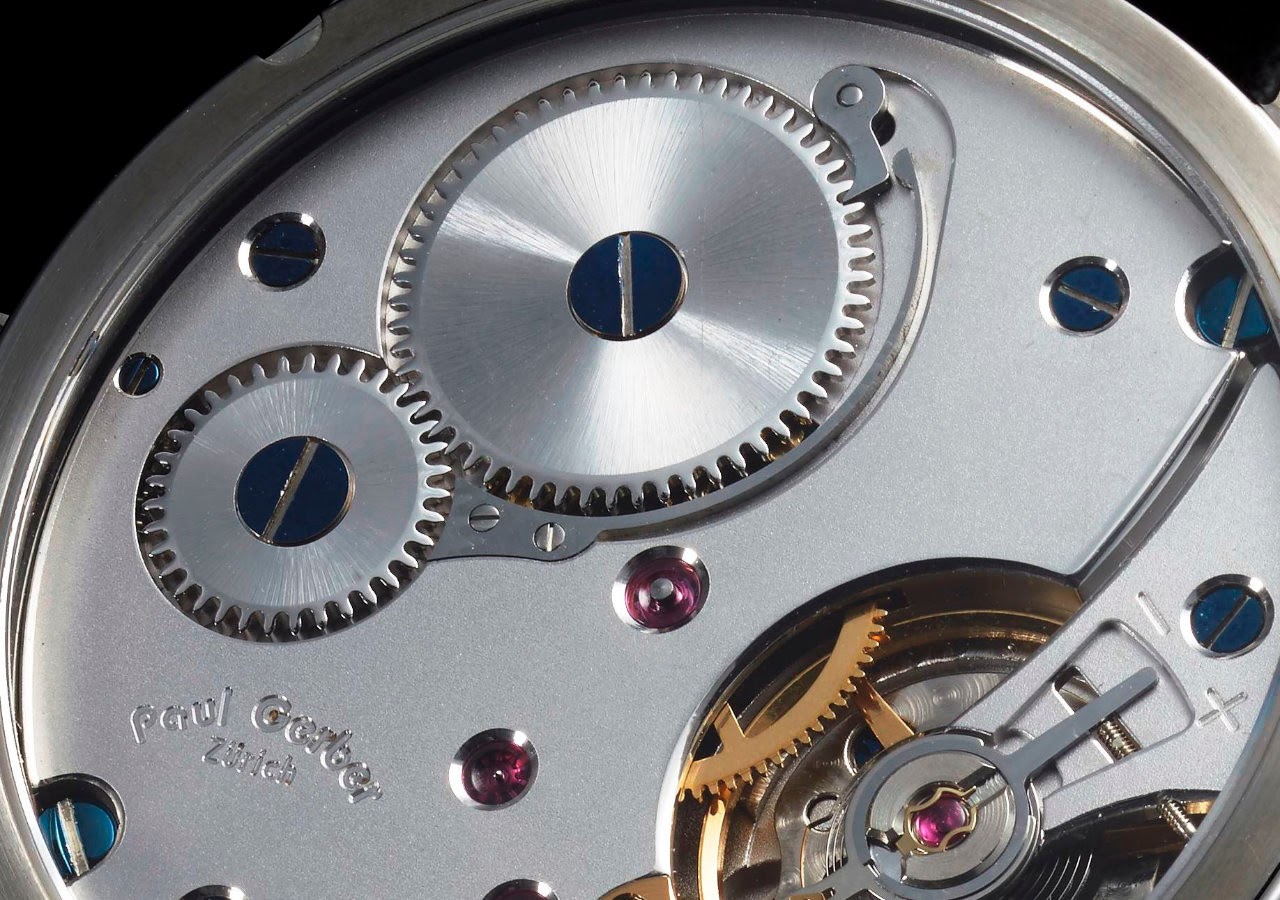
The first task towards creating our own watch was
grinding the surfaces of bridge and cock on gradually finer emery paper; later
the name plaque was also very lightly satinated or
polished (depending on preference of the participant). Paul Gerber used to
schedule this job after bevelling the edges. Unfortunately, too often nicely
prepared anglage was damaged by clumsily handling the
pieces in their further treatment (like using too much pressure when grinding).
It seems also better to “warm up” the participants with such a straightforward
job.

Beautifying plate and cock were by far the most time
consuming jobs on hand. There were no inward angles to work on, but I could now
understand how expensive hours are just rushing by when a plethora of tiny
parts must be made perfect by hand work. The importance of the correct
technique was highlighted too, i.e. we had to guide the file in flowing strokes
and not scrape backwards and forwards on a tiny area at a time. With the
cut-outs in the circumference of the bridge the prescribed method had its
pitfalls, like the emery paper being torn when it caught on sharp edges.
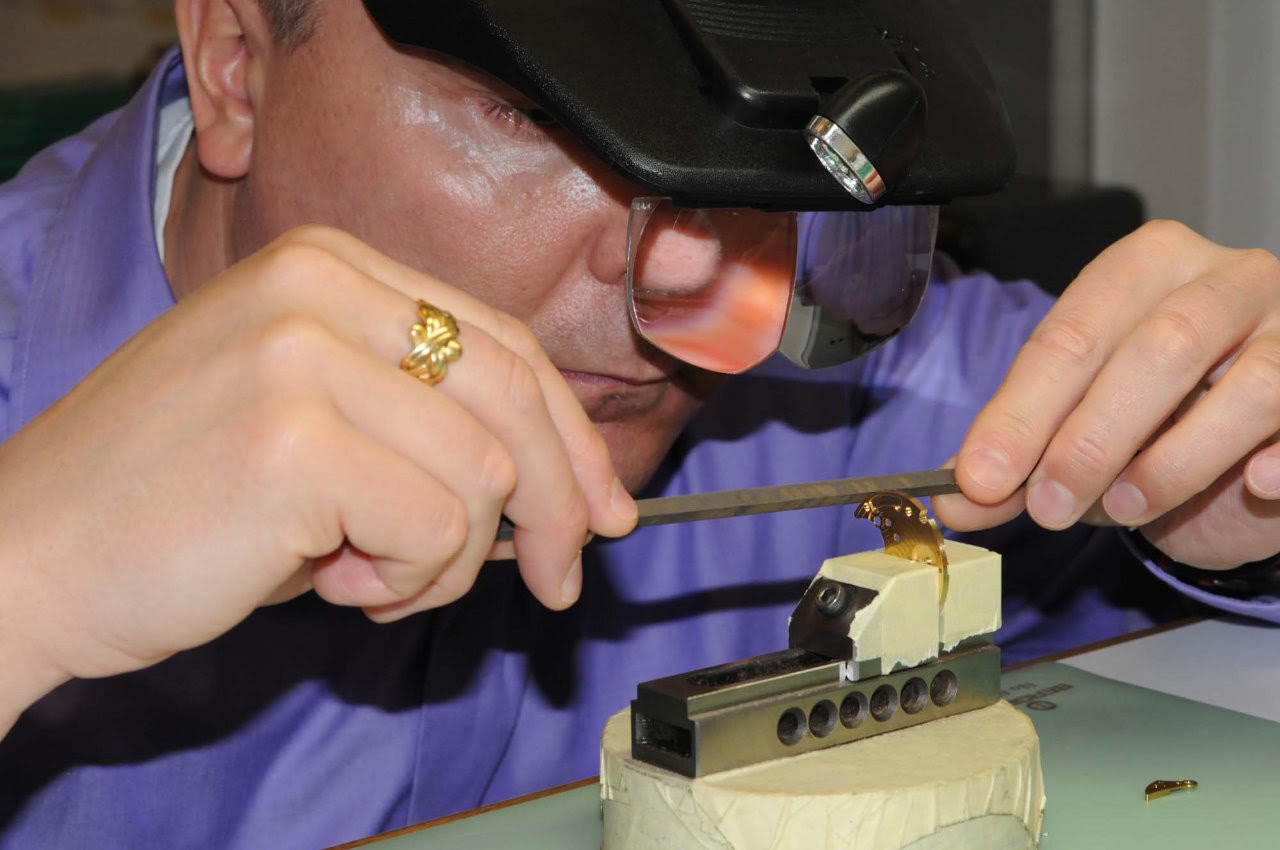
Paul Gerber explained how the typical anglage of 45° when machining parts does not work when it
has to be visible from different angles in an encased watch movement. The angle
has to be about 30° to reflect the light when looking straight on through the
sapphire back. Ideally the anglage should even be
slightly rounded, not only to differentiate it from machine made versions, but to
make the viewing angle less critical to catch light reflections.
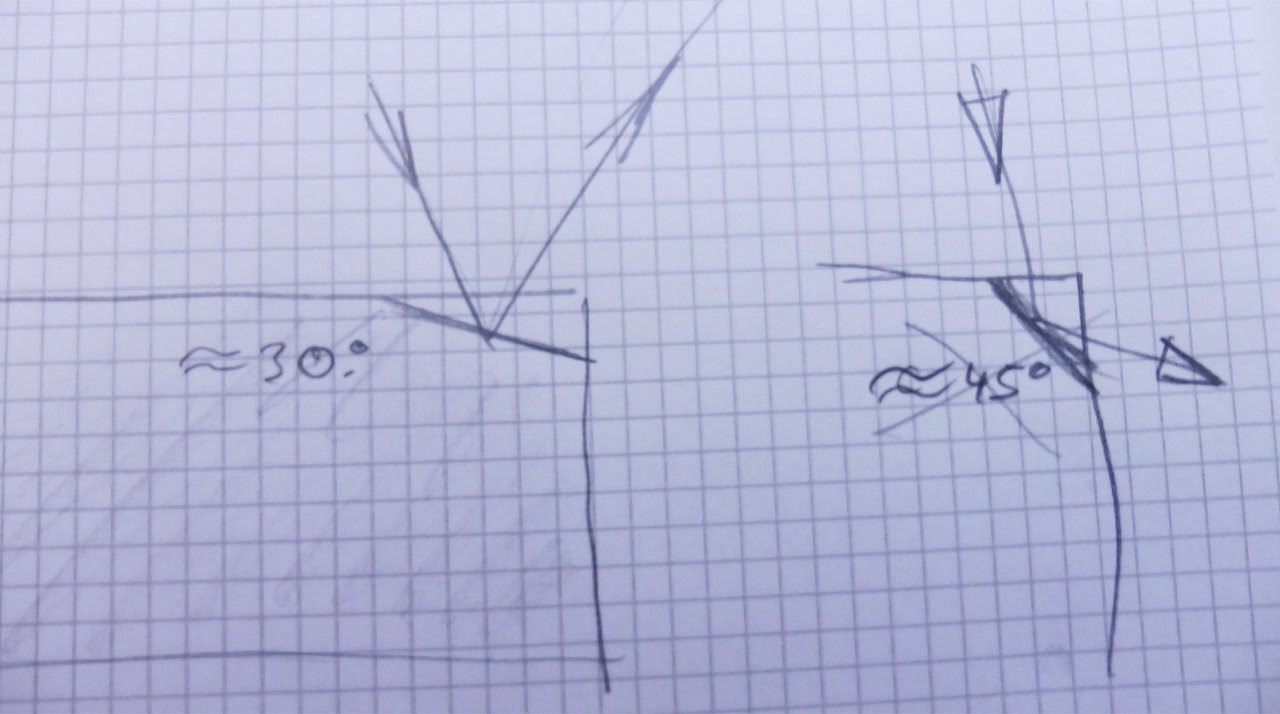
In addition to the emery paper mounted on boards and
the zinc plate with diamond polishing powder (to treat the flat surfaces), four
tools were available to us for the detailing of parts (from the top):
A triangular wooden piece (a mini sanding block called
“Holzschleiflatte” in watchmaker’s
speak) covered with fine abrasive paper was used to smoothen the lateral
surfaces of bridge and cock. The chamfers on the parts’ edges (the anglage) was prepared with a crossing file (“Vogelzungenfeile”) and then refined with a fine grinding
file (“Schleiffeile”). Again, it was important to
work in fluid, long strokes, what is quite tricky when the angle the tool is
set onto the parts should also remain constant.
The carbide tip (“Hartmetallspitze”)
was only used for the detailing after the bead blasting of the parts.
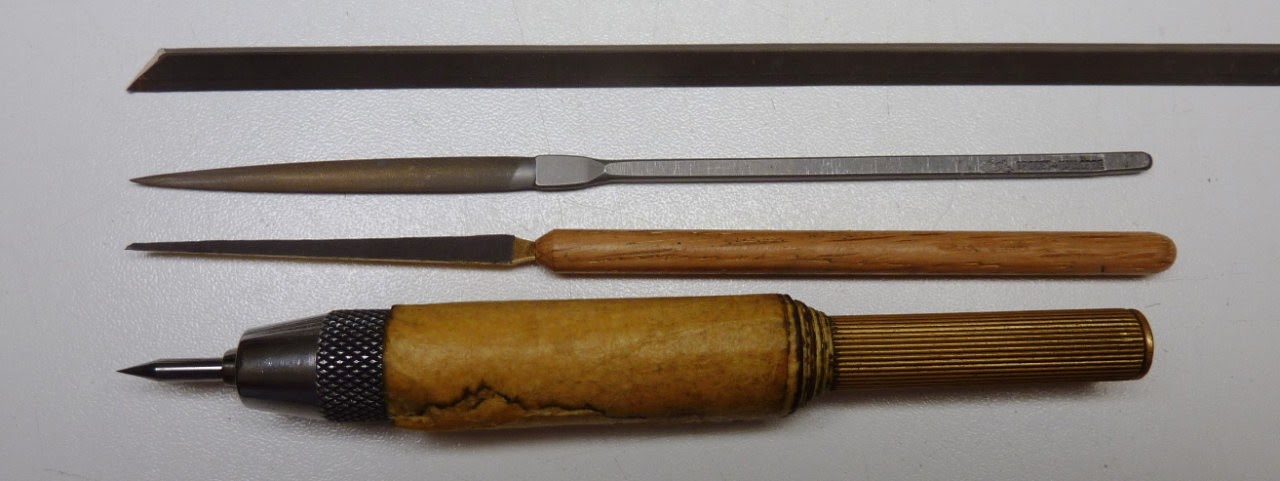
All this abrasive work had to be done freehand. An
engraver’s ball with the cock mounted on the supplied tool helped a bit.
Without practice with this kind of work, it was also rather awkward for me to
always work “from below”, i.e. never attack the edges for the anglage from above the piece. This constantly repeated
advice of Paul Gerber should avoid scratches created by a slipped tool.
Scratches on work pieces are the absolute nightmare scenario,
because too much material would have to be removed from a piece to let such
marks disappear.
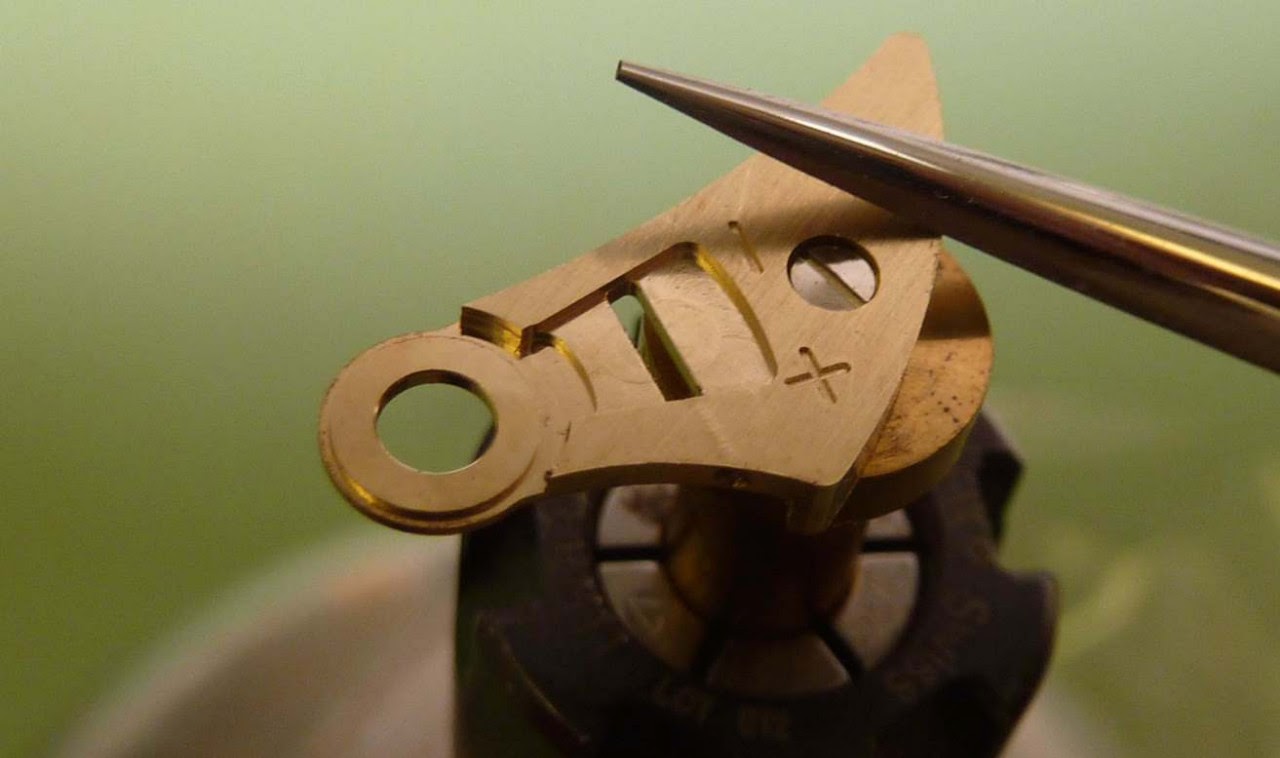
The hockey pucks in the background were provided as
ideal working surfaces, being hard without scratching the parts. The puck stack
brought the parts to a height avoiding the grip of the tool banging on the
table when we had to work on the anglage with moves
exclusively from below the part. With practical thinking, you don’t need to buy
expensive tools and fixtures for every task!
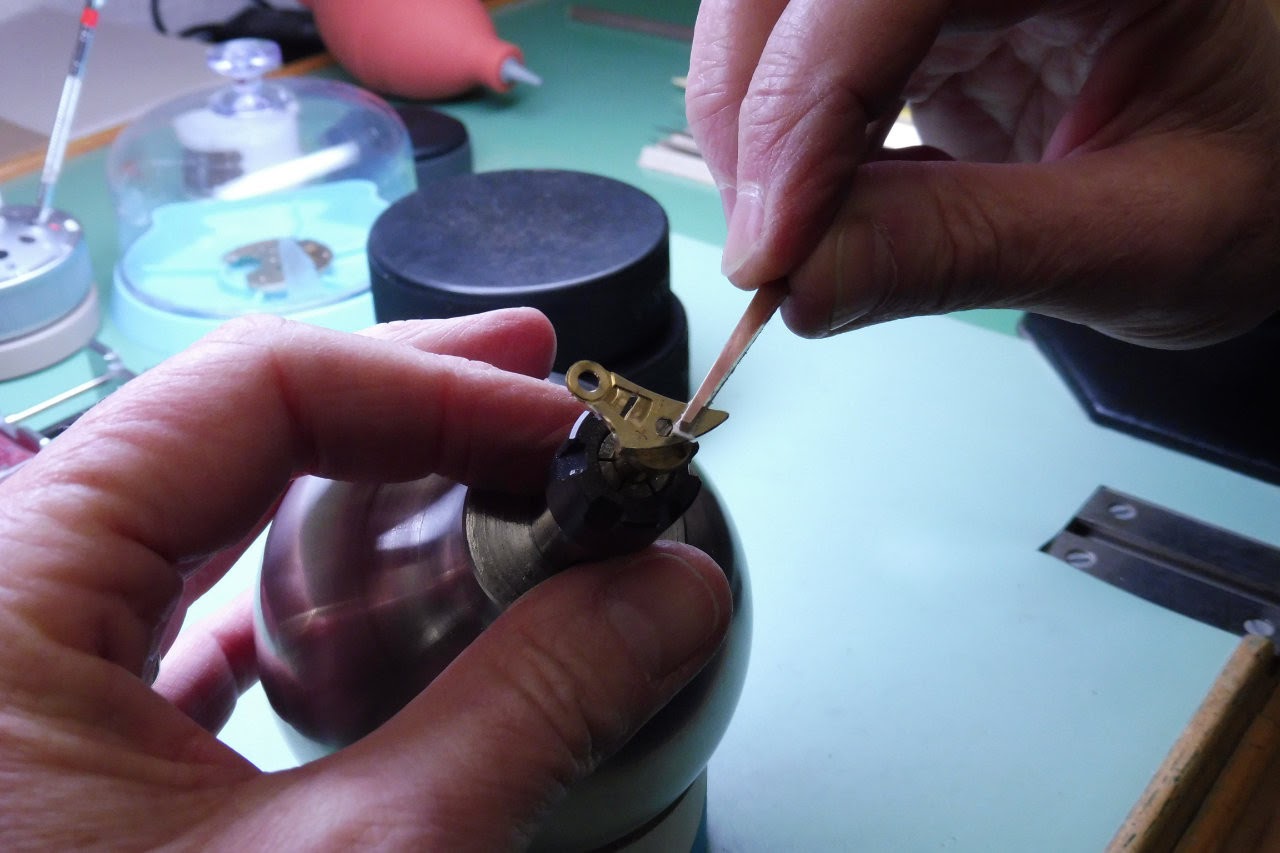
Not having seen the “famous” gentian wood sticks used everywhere
in the Vallée de Joux’s
fine watchmaking ateliers, I teased Paul Gerber, asking if he is not using them
for the final detailing. Well, the joke was on me, because he not only fetched
a whole bunch of these sticks (supplied by none other than Philippe Dufour) from a cupboard, but also presented the other use
of this tool providing plant: Schnapps made from Gentiane!
Sniffing at the latter, we agreed the first impression could be of a cleaning
fluid…
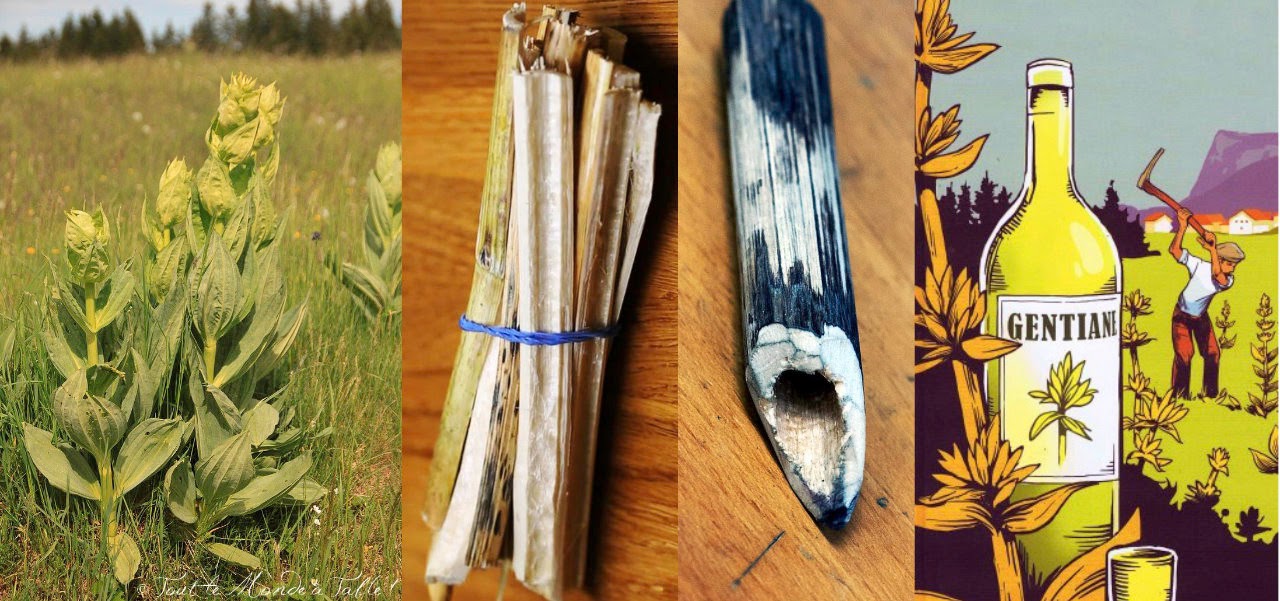
Paul Gerber explained that the tools we use for the anglage would in any case not be approved by these masters
of the Vallée de Joux.
Though, their tools (also used by him) require the proper technique as well as
a lot of practise for the sought after results. For example, the real masters
are not preparing the anglage with a file as we used,
rather a tool (looks like a scraper to laymen) to actually cut material from
the edges of the parts to create bevels. They also do not use fine emery paper
stuck on a triangular wood piece for a file as we did. Our tools are more
forgiving. On the other hand, they would not allow creating an inward angle,
for which really hard tools are necessary (Degussit
files, or ordinary nails together with abrasive paste etc.).
For Paul Gerber it is important every course
participant manages to create a nice anglage with a
bit of care, and not that pure luck decides about the results if more
aggressive tools would be used without years of experience.
To help towards a good result, he checks then every
step of our work before we could move to the next job on hand. When he looked
at my anglage, I saw the wrinkles on his forehead
deepening. He promptly told me off to have avoided by a hair’s breadth ruining
the bridge with my anglage. When I worked on the
part, I had the broad chamfers of Philippe Dufour and
Akrivia in mind, so I also tried to extend the anglage a bit more into the flat of the bridge. Paul Gerber
is foremost an engineer and is not keen on such show decorations; for him a
discreet bevel has just to bring a bit of visual “life” into the part with a
sparkling effect. Though, after the bead blasting and further treatment of the
bridge it all worked quite well and I believe he also enjoyed the more easily
visible polishing in the end.
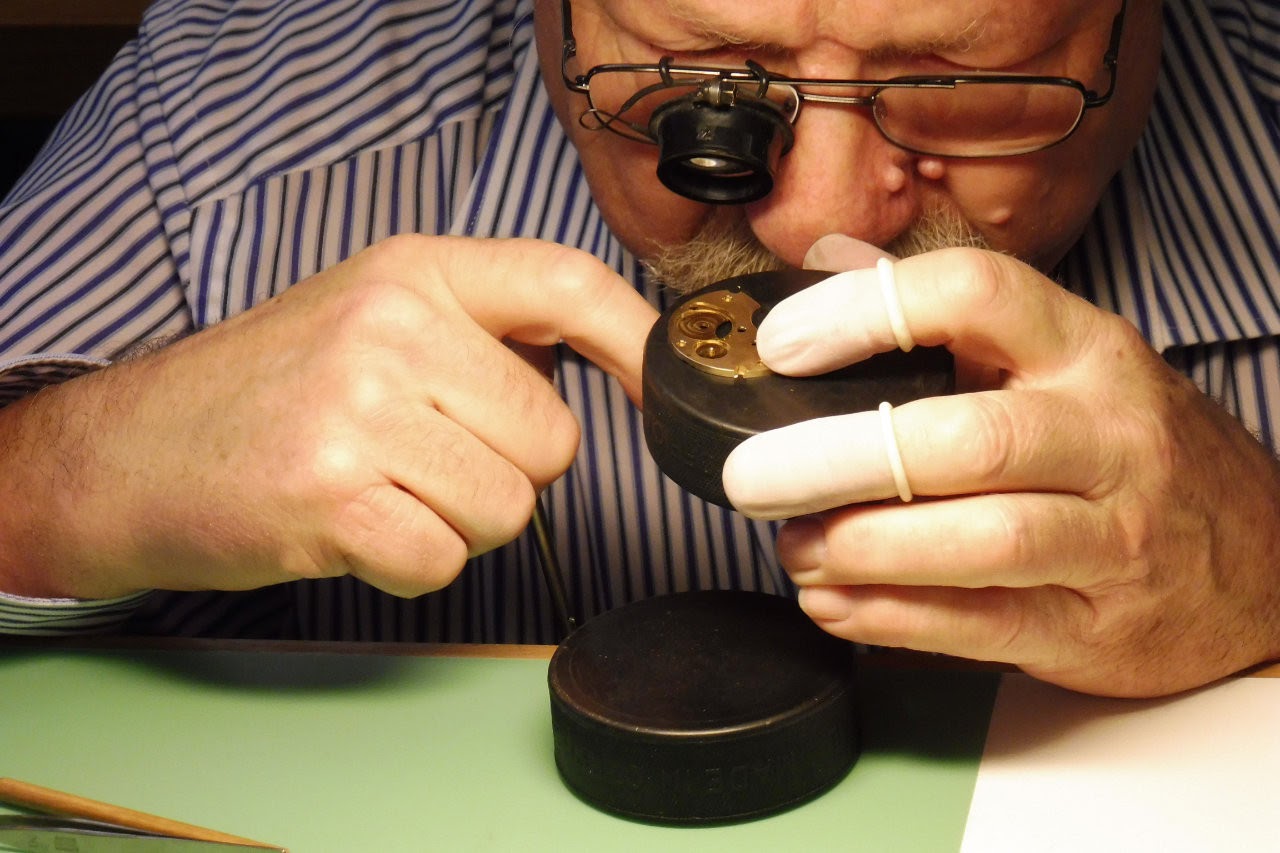
After all these abrasive work on the parts, they were
cleaned in an ultrasonic bath. Because any grease or other soiling would show
permanently after the following processes, we could not even use the compressed
air for drying (for fear of tiny residues of oil in the air), but only a small
hand-operated air pump. From now on the fingers had also to be protected all
the time by the rubber fingerstalls provided.
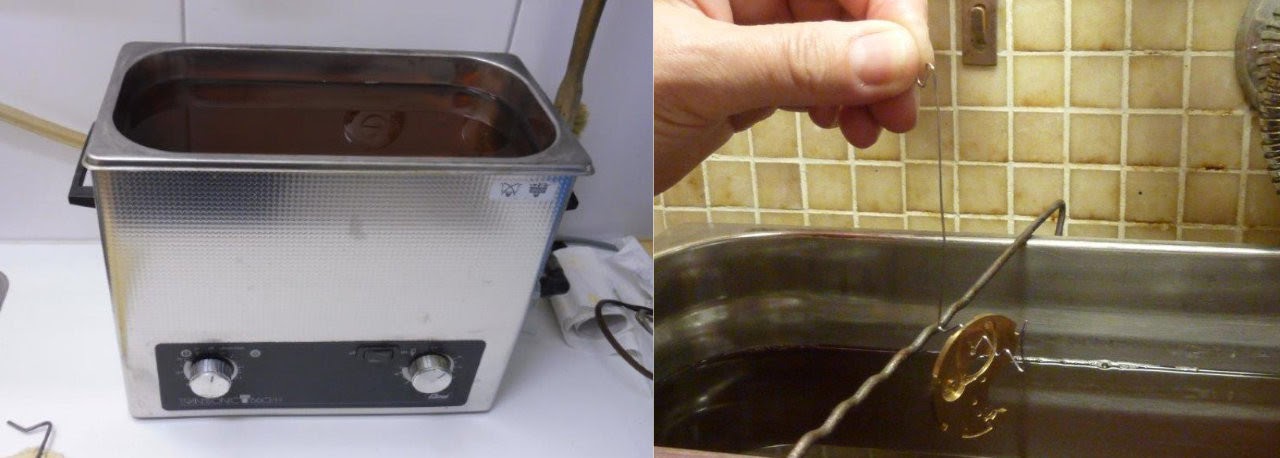
With no Geneva stripes on bridge and cock planned, a
discreet “frosting” had to provide an interesting surface structure. Instead of
using sand or glass shreds (both abrasive treatments) for this blasting, Paul
Gerber has the machine filled with small glass balls. These create only
delicate dimples on the surface, which stays smooth enough to still allow some
mechanical cleaning (with a cloth etc.).
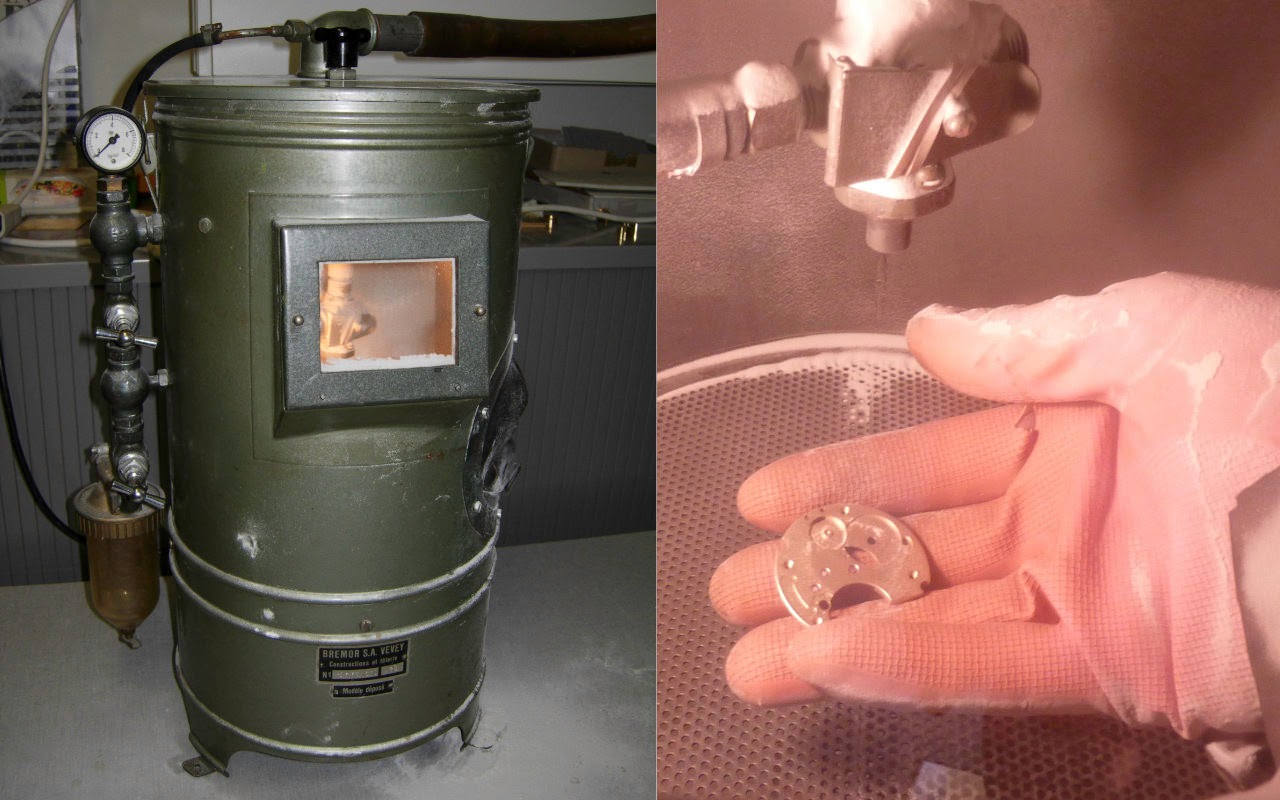
The glass
bead blasting brings only a very fine structure to the surface of the bridge
and cock. This is already sufficient for the parts to look “dead” after this
treatment.
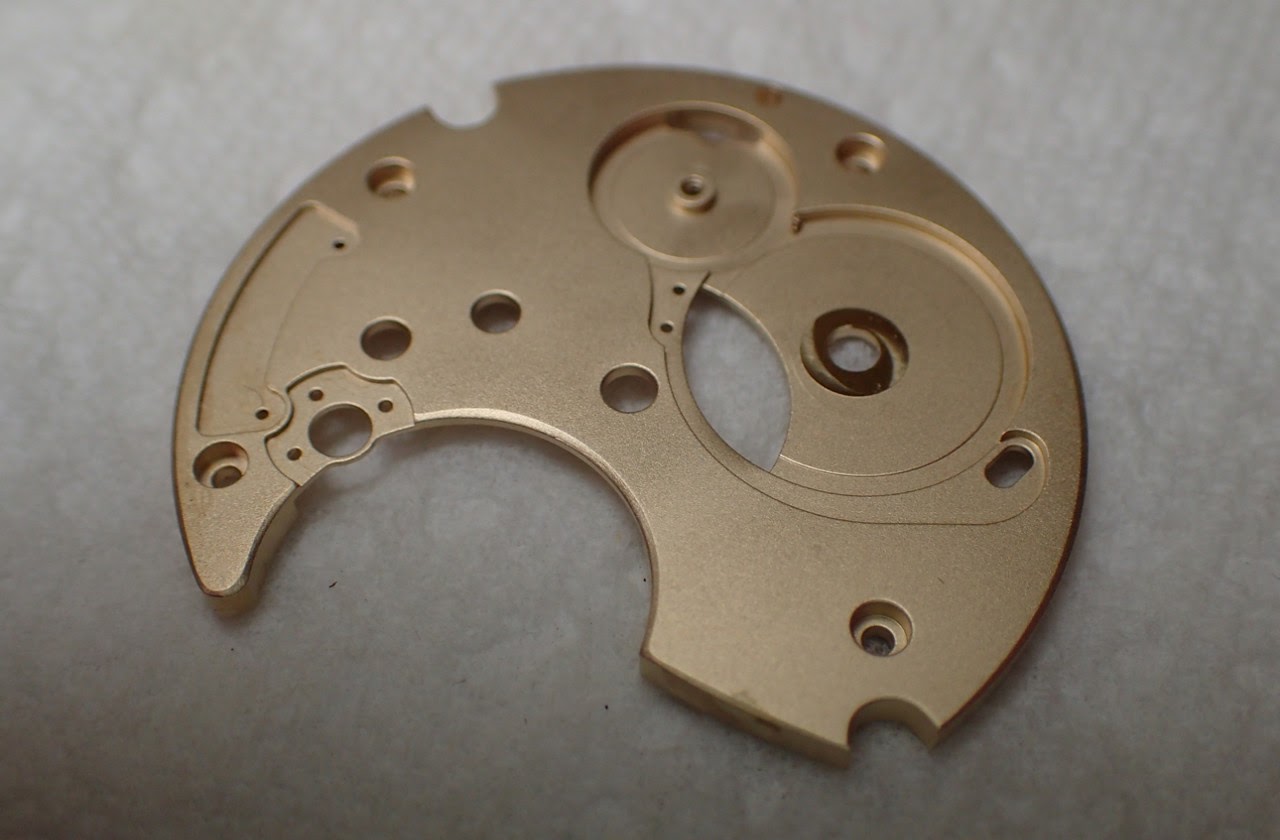
To bring back some sparkle, the anglage
has to be worked over with a carbide tip (spike). With this treatment the sheen
of the chamfers comes back and the material at the edges is at the same time
compacted.
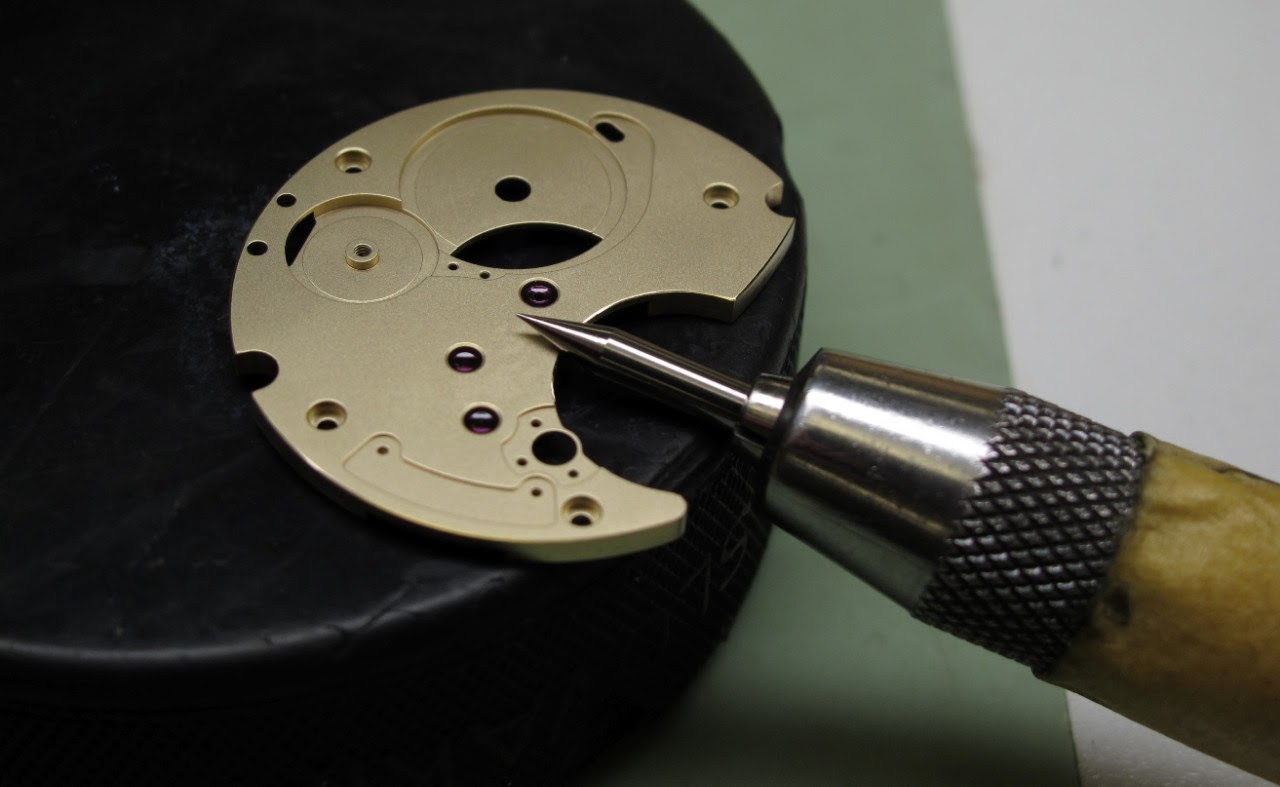
The holes for the ruby bearings and screws in bridge
and cock were bevelled with wheel countersinks (“Rollensenker”),
first fitted with a metal disk for an abrasive effect (and compacting), and
finally with a sapphire disk for the polishing.

The sapphire disk is used to brighten up the screw and
ruby bearing holes. Paul Gerber advised to lightly run these disks first along
the side of our nose because this provides just the right amount of grease for
the operation.
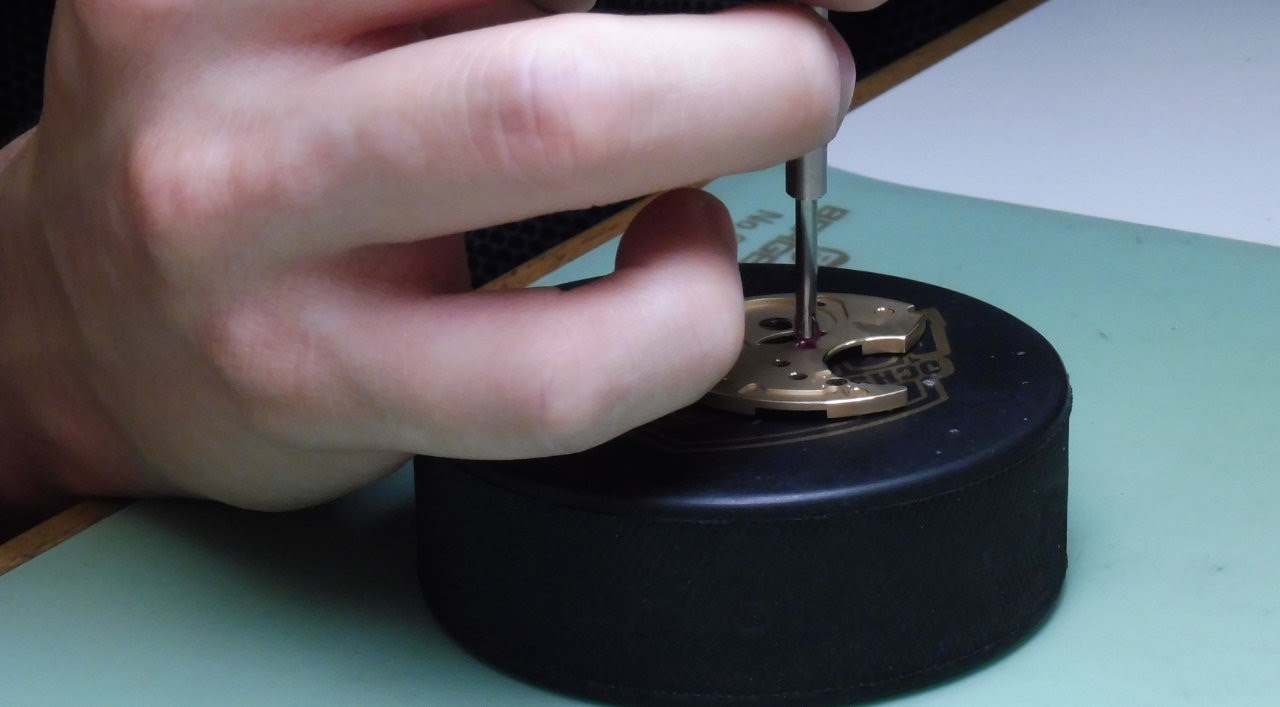
Then it was Paul Geber’s turn again, to mill his name
and place individually into the bridges. This milling is only done at this
stage to retain sharp edges and the brightness of the milled recesses. Doing
this operation before the glass bead blasting, the crispness of the signature
is completely lost (as can be seen with the “+/-“ regulator
indices on the balance cock). Not to do this milling as part of the preparation
of the new parts has the additional advantage of providing an interesting
break, so we could witness some milling being done on parts of our own watches.
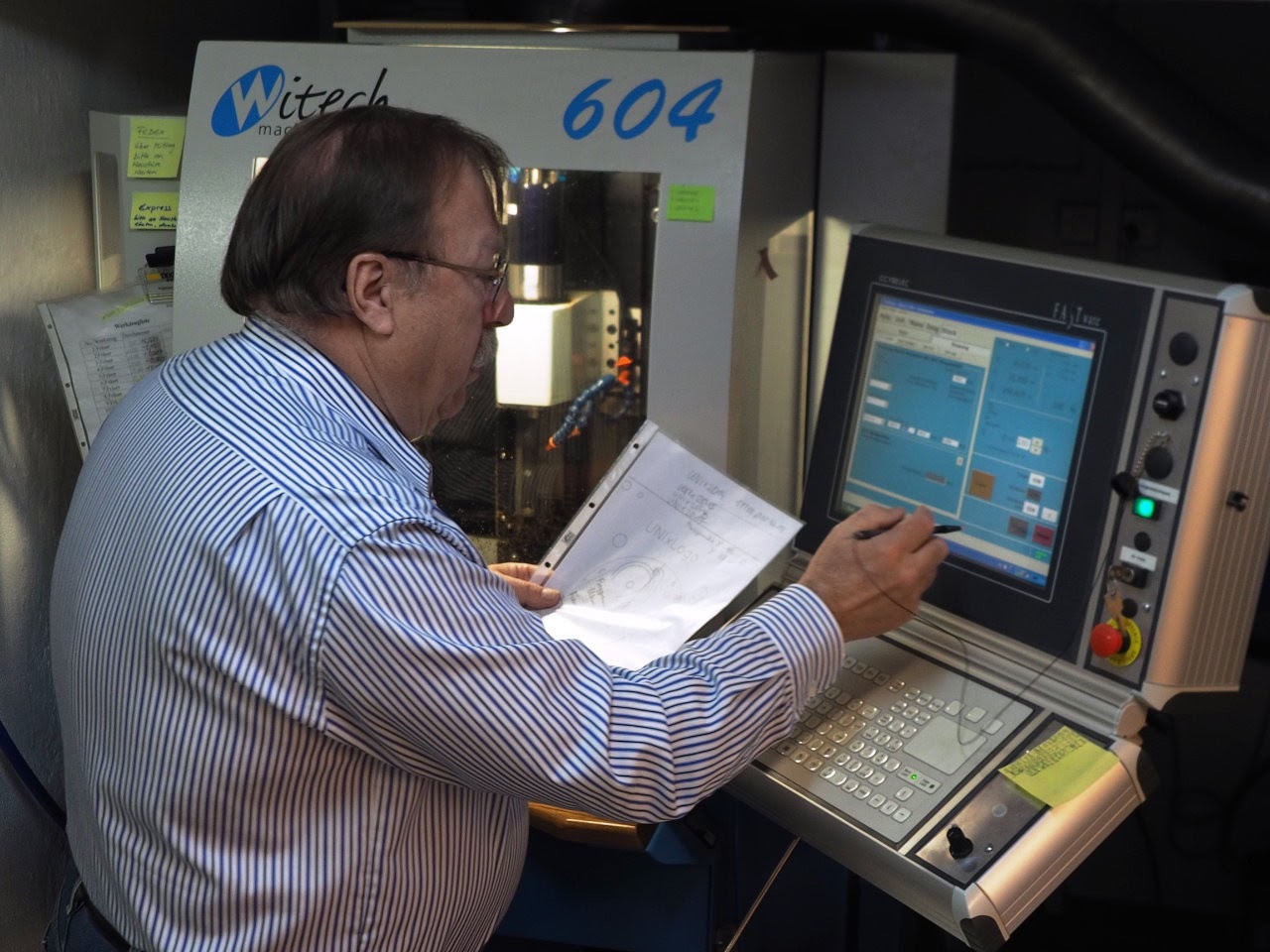
Paul Gerber has chosen a three-axis CNC mill, mentioning
a five-axis one would not have cost significantly more, though, would only be
needed to manufacture the cases. He belongs to the group of master watchmakers
able to also build the cases in-house (and he does build the prototypes,
replacing the missing fixtures on the CNC mill with handwork), but he decided
specialists doing nothing else are just a tick better. To really deliver
perfect results, the manufacturing operations and techniques must be mastered
in your sleep; if you have to think first how to do something (because you only
do it from time to time), it shows plain lack of experience and cannot lead to
the best results wanted, according to him.
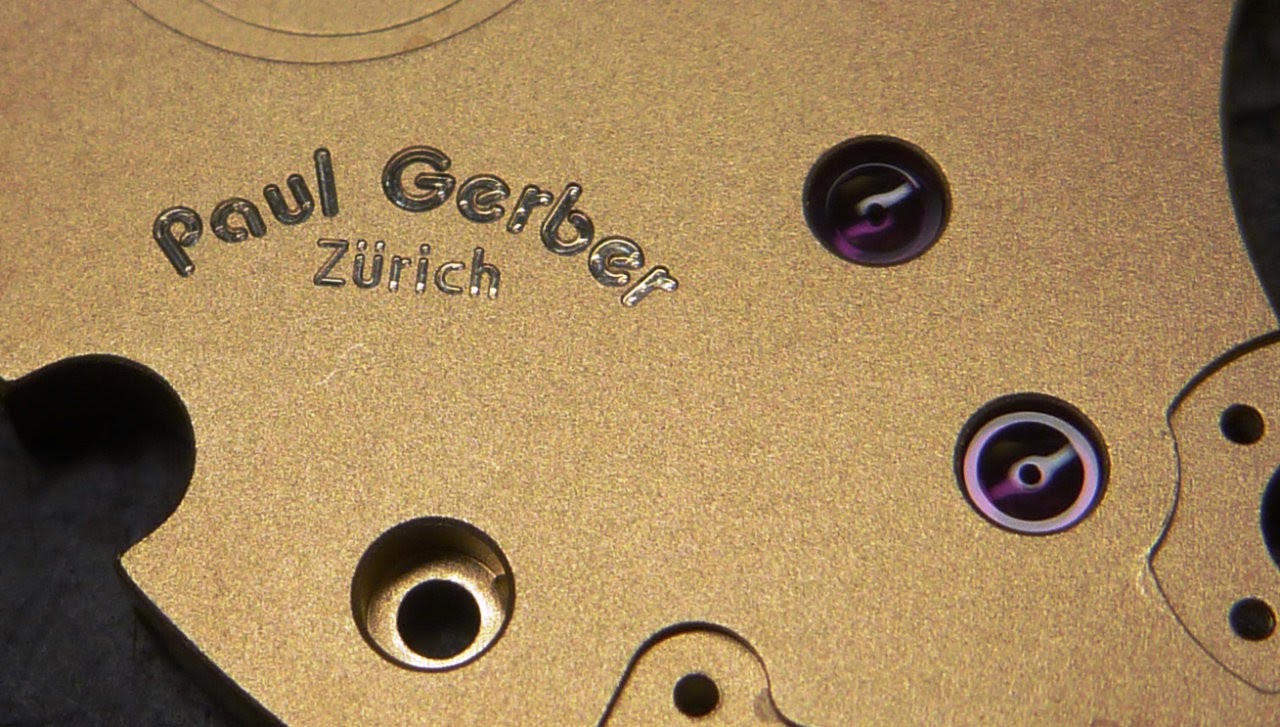
The bathes for degreasing (at 6 volts) and the galvanic
bath to plate (at around 2 volts) bridge and cock are installed in the toilet
when required. I left these critical treatments to Sean Fuchs, a former
employee of Paul Gerber, who supported him from the second day onwards with the
more tricky jobs we amateurs could not do confidently on our own.
Since I associate yellow or red gold plating with
German watches, I am glad Paul Gerber had chosen a rhodium
plating for our watches.
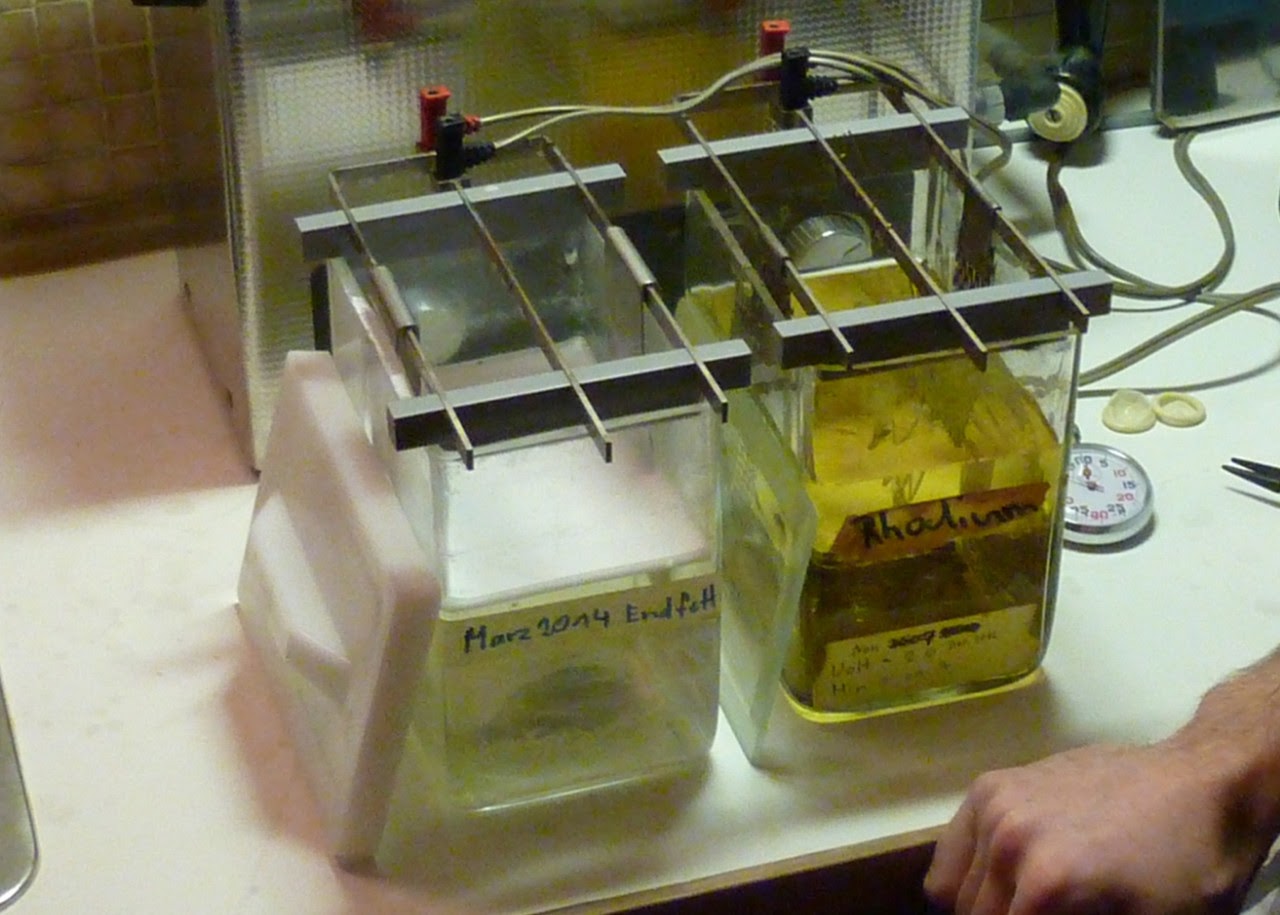
In addition to threading small parts with a hand tool,
we could machine the dial feet on a small lathe (the watchmaker’s “classic”
tool, a Schaublin 70, of course), instructed and
supervised by Ruth Gerber.
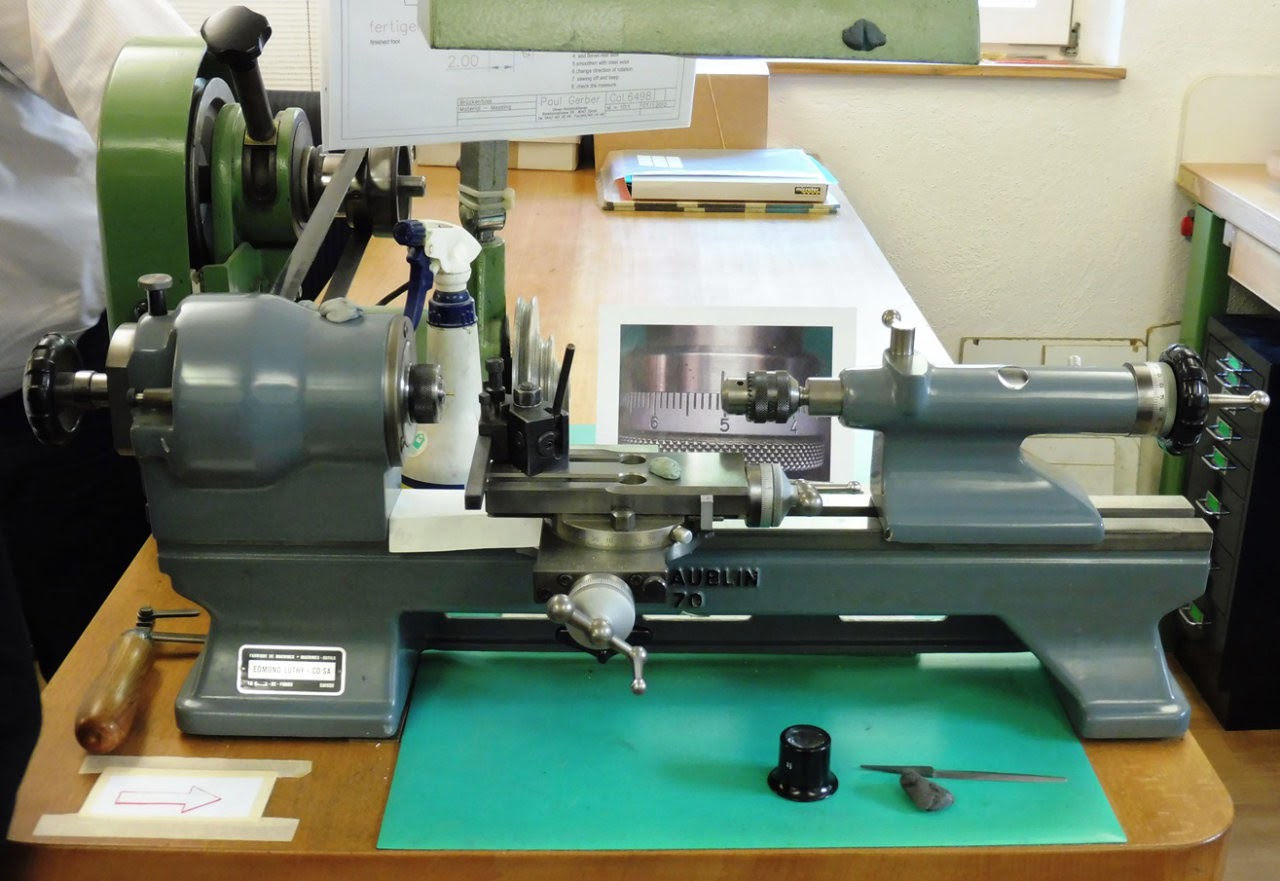
The lathe was already set up for us, but reading the nonius to translate the dimensions in the plan to the
workpiece was difficult enough. Ruth Gerber had to keep a very sharp eye on the
scale when I turned the handle to advance the milling tip.
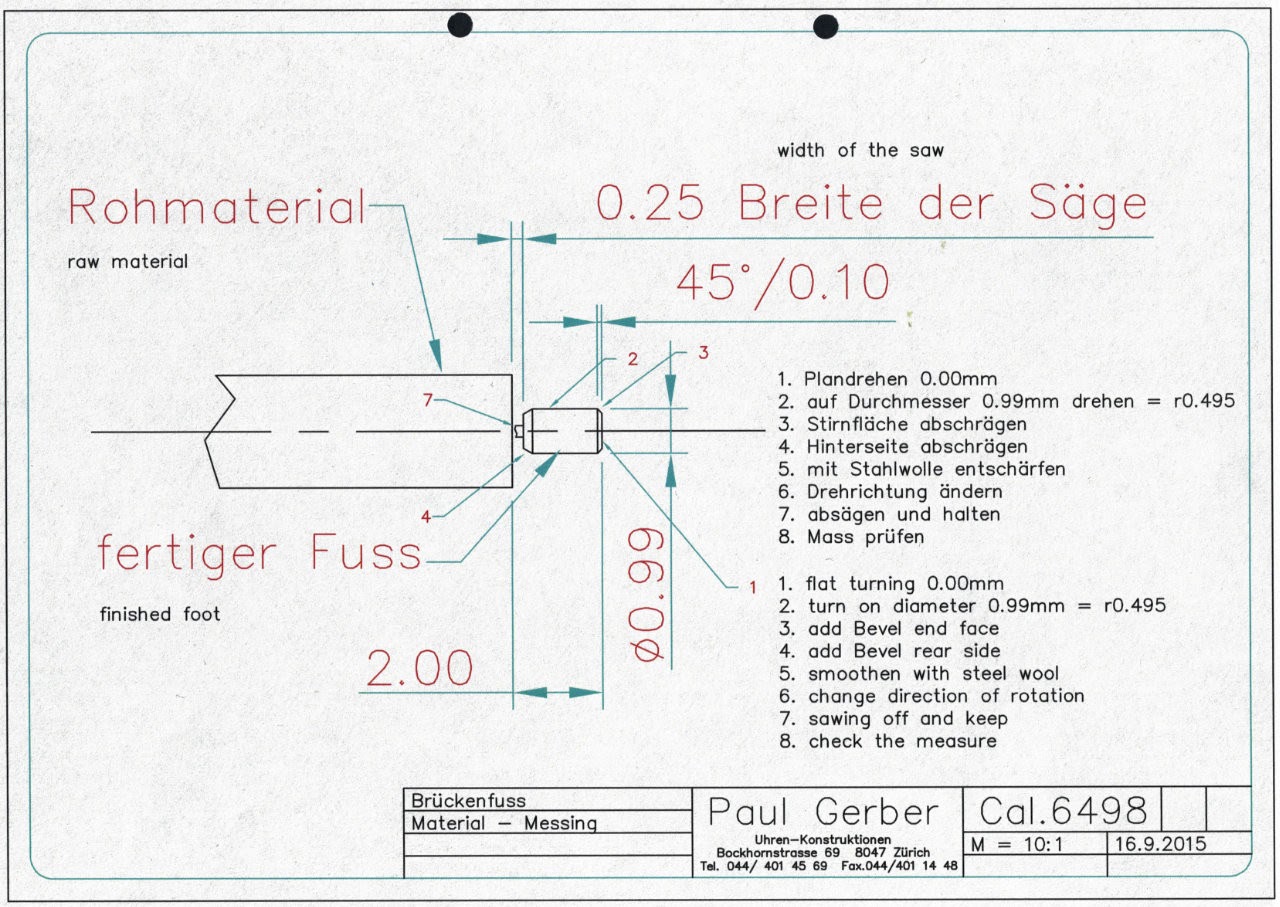
A slight bevelling of the feet was created by holding
a file gently on at a (preferably...) 45° angle while the piece was still
turning in the lathe. Deburring was done by swapping the file for a bunch of
steel wool.
To cut the feet off from the rod at the correct
length, a hand saw blade was held on the turning piece, with a finger
underneath to catch it. For this operation the lathe had to turn backwards (to
get the sawing action from the stationary blade). Due to a slip of attention on
my part, I forgot once to change back the direction of rotation again after
this operation. When no cutting action happened trying to turn the next feet,
even a layman realised something was amiss and I stopped work. This wrong
handling was already enough to require resetting the lathe to keep all the
tolerances. This just showed how quickly a loss of concentration can ruin parts
in watchmaking and waste a lot of time.
That the dial sits properly and is not distorted by
inserting manoeuvres of amateurs, Paul Gerber took it on him to fit the feet we
had produced later on.
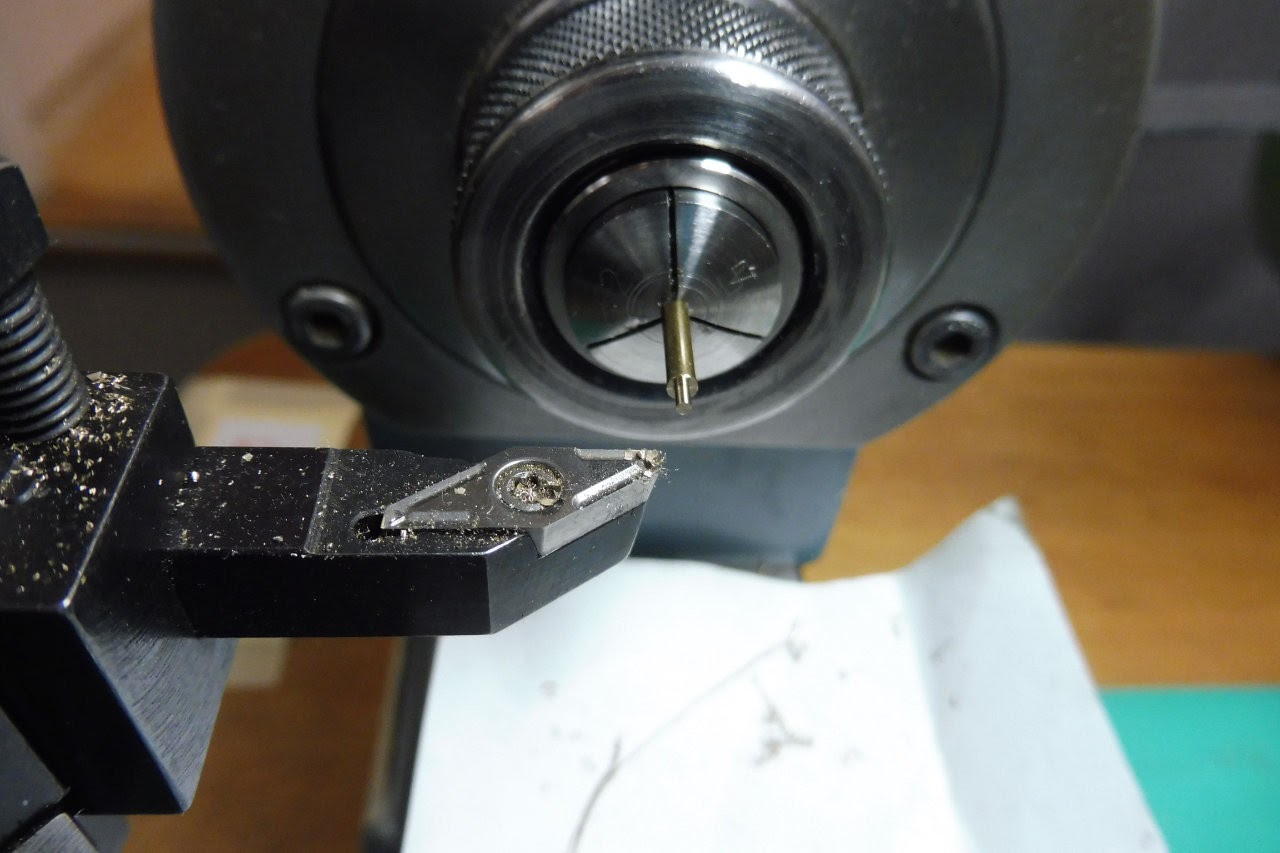
Next part to get treatment was the ratchet wheel
click. The method Paul Gerber uses to harden this part is a combination of
simple tools and suitable materials to keep the labour invested as low as
possible without skimping on quality. The click had first to be wrapped tightly
with ordinary tie wire. This helps to distribute the heat evenly on the part
when “glowing” it with a blowtorch. On the other hand, the click spring is too
delicate for this method (it distorts and has to be trued afterwards), which is
why we got this part already in finished condition.

To avoid the part getting black in this hardening
process, we had to dip it regularly into boric acid powder, thoroughly covering
it. The part was then quenched in a water bath. When asked, Paul Gerber stated,
using oil is not necessary in this process and would only blacken the part,
thus requiring additional cleaning work. Tempering the part (below RH) removed
the surface tension after the hardening process.
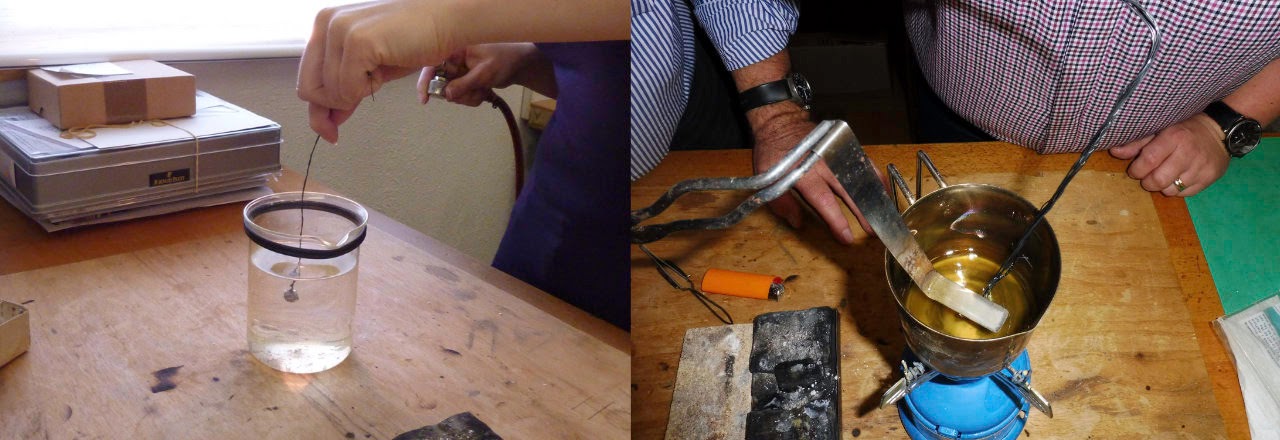
The click had to be polished with diamond powder on a
zinc plate after the hardening processes. While the master has no problem to
keep the small part under his finger absolutely level, there was an acute
likelihood it would not work like this under our fingers. The small tool
provided by Paul Gerber allows fixing four clicks on with screws and shellac,
making it impossible to create a skew on the part by incompetent polishing.
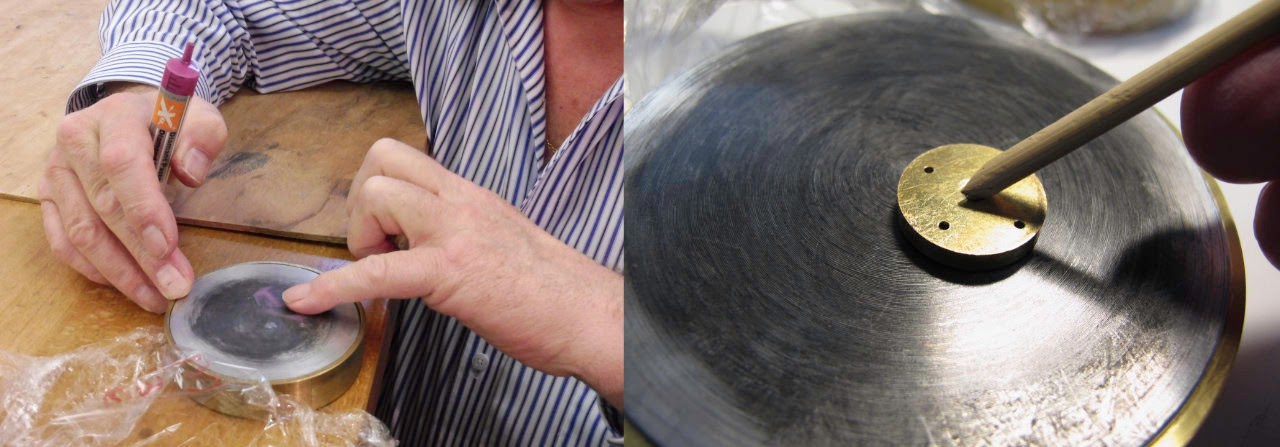
After
polishing, the clicks were removed from the tool with a heating plate and
spirit. They were now ready to be fitted onto the movement.
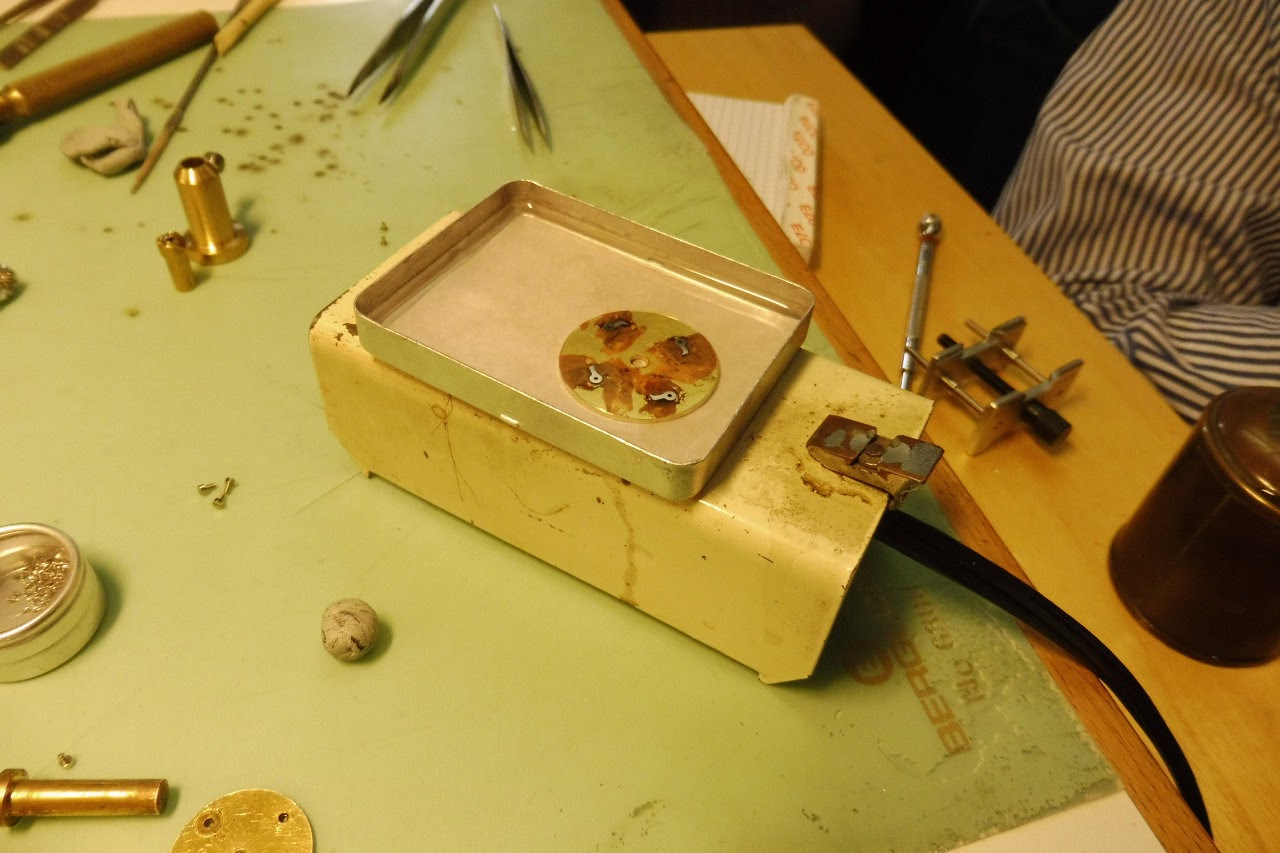
A similar tool is supplied to hold the screws for
their treatment. With an old gramophone needle (!) we sled quickly through the
screw slot with some pressure to put a slight anglage
on. Paul Gerber had prepared the needle’s shape and size to no reach down to
the bottom of the slot, to avoid scratching the nickel coating there.
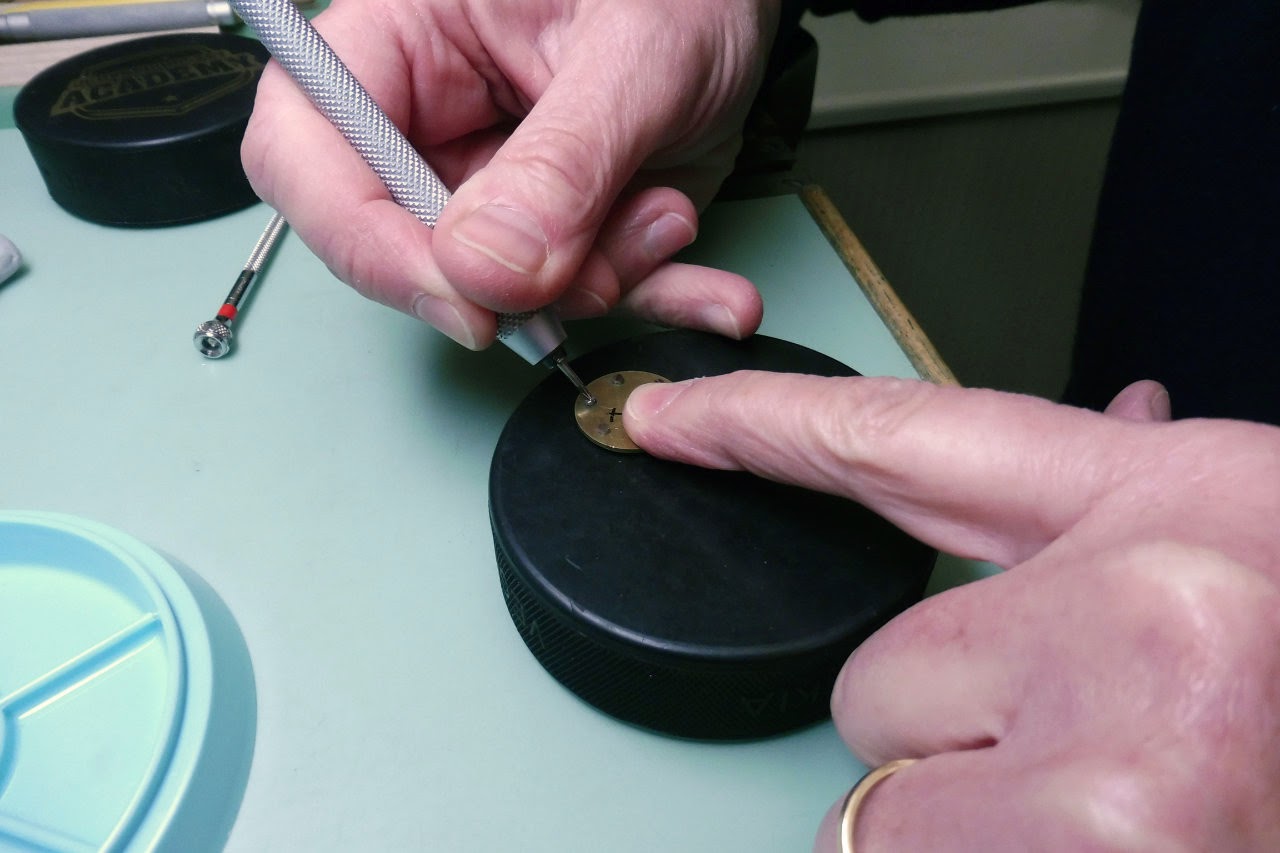
We resurfaced and polished the screws with the same
method as the click in preparation of their blueing. Paul Gerber uses in the
course a chemical treatment instead of flame blueing. An annealing salt (“Bläusalz”) is dissolved by heat and the screws hung into
this bath until they turn the desired blue colour.
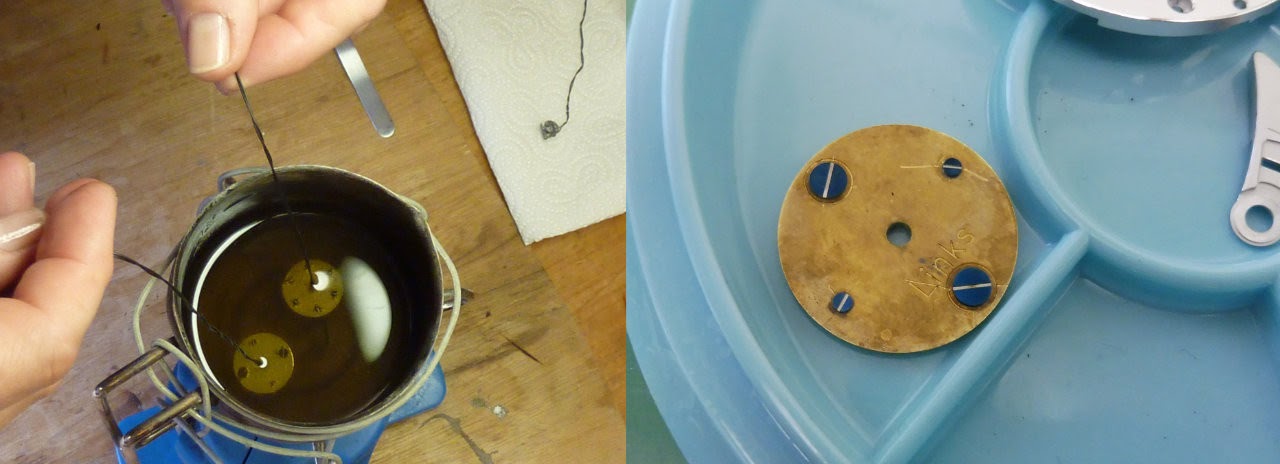
Cooled and washed in warm water, the screws are a nice
even blue, but the slots stay “white”. To keep this “white” uniform, it was
important not to reach down into the slot with the gramophone needle. The undisturbed
nickel plating prevented the blueing of the slots. For a “full-on blue”, the
bottom of the screw slot would have to be ground and polished, removing all nickel
coating. This operation by the hands of laymen is too risky for Paul Gerber; ruined
slots/screws would be the result with almost certainty. The flame blueing
method would not change anything in this dilemma, because the nickel plating
would still have to be entirely removed.
The gold châton brings no
technical advantage; it is integrated to further pep-up the visuals of the
movement.

We could fit the jewel bearing ourselves with the help
of a small hand tool. Fitting the balance jewel and shock absorber was deemed
to critical and was done by Paul Gerber.

All the pupils opted to work with ordinary glasses
creating a magnifying effect. I was unable to do anything with a watchmaker’s
loupe covering just one eye, because all perspective viewing got lost. This was
particularly acute when I had to oil shafts, requiring a tiny drop of oil
placed exactly at the right position to avoid soiling and clogging-up part of
the movement. This “operation” was impossible without the use of a loupe. Not being able to place the oil spending needle
accurately, I had to delegate this job to Sean Fuchs.

There were also some tiny screws (e.g. for the click
spring or the name plaque) with only about one turn on the thread to fix them.
The risk to destroy these screws was so high Paul Gerber discouraged us
actively to try this installation work ourselves.

Testing my finished watch on the Witschi
timing machine, the accuracy was even a touch better than with the original ETA
movement. So, my hopes are intact that this time the self-assembled watch is
not again stopping to work after a relatively short time. While Paul Gerber
would certainly appreciate if I would use it as a daily beater, I don’t want to
risk it this way, and so it will get the same treatment as the other pieces
with “collection” status.

Not much help respectively advice was received to
choose dial and hands from the assortment presented to us. I made my choice
very quickly nevertheless, because in my mind I had already decided before the
course started how a “typical” Gerber watch has to look. Loving blue, the
colour of indices and numerals on the dial was a given. For a sporting look I
wanted also the blue rubber strap on offer.

Paul Gerber manufactures the engraved dials as well as
the milled numerals and indices himself. It makes such a difference to have the
third dimension on these parts instead of just having to look at thinly
printed, flat ones so common even with higher priced watches.
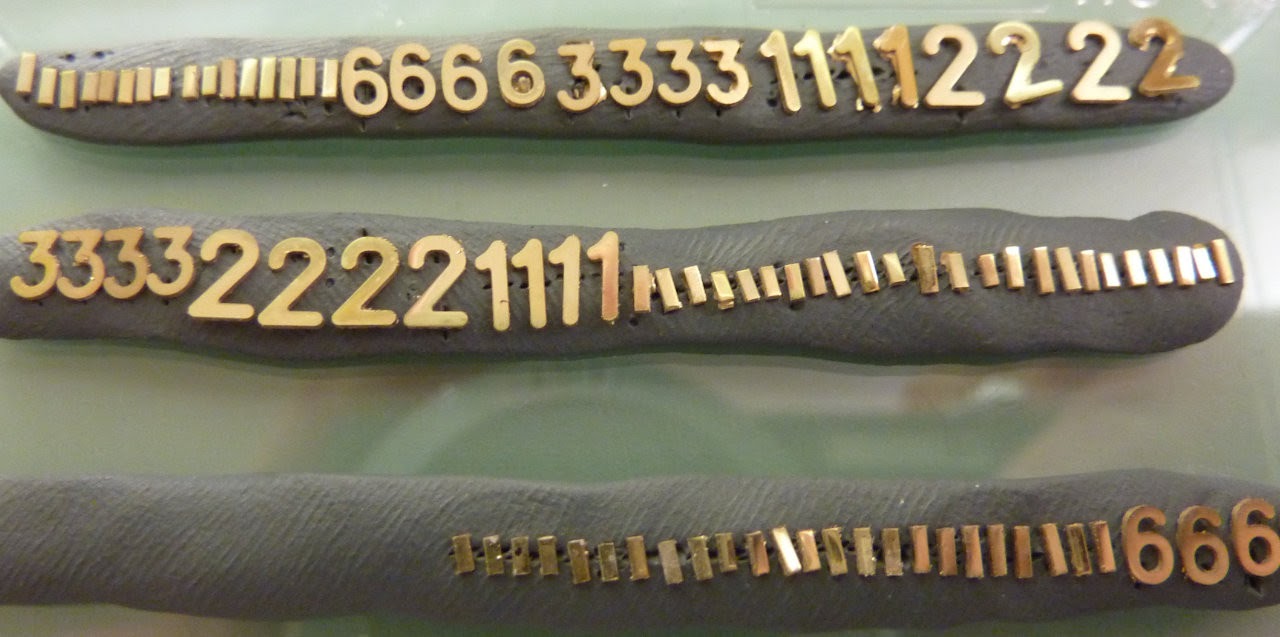
The hands are milled in house, including all further
work like blueing, rhodium plating or polishing. This in-house production
ensures also hands with the correct length for the dial design.
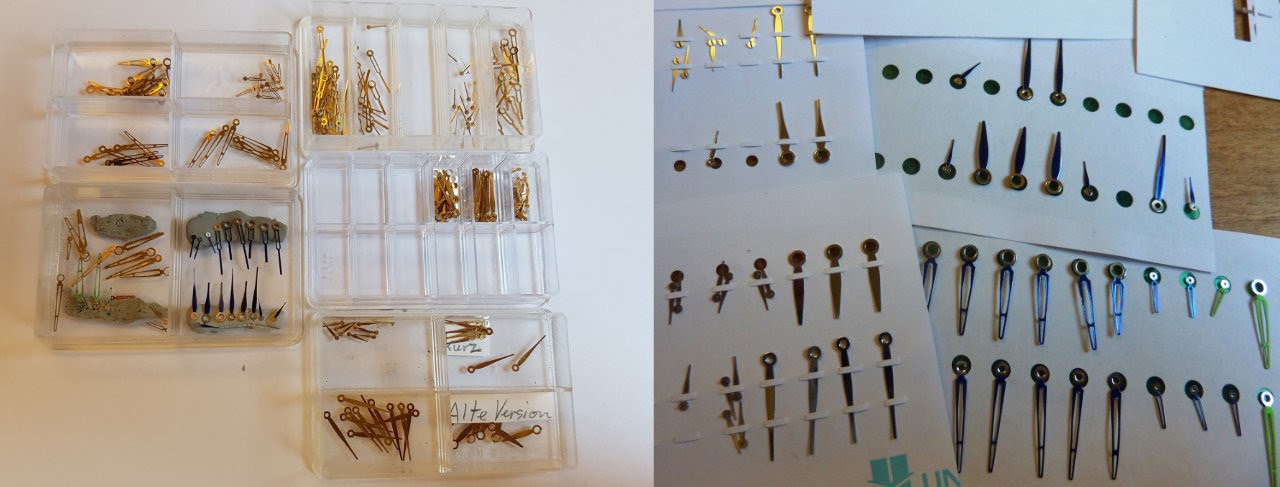
Which hands had to be used to make my watch a “real
Gerber”, I had decided long in advance. The choice was confirmed when hearing
the story behind this particular shape I wanted: Paul Gerber had years ago an
enquiry of a public transport company of Zurich to create an anniversary watch
for them (which never materialised); he had then the idea to create hands
picking up the graphics of a tram track plan (the ones at the bottom of the
photo below).
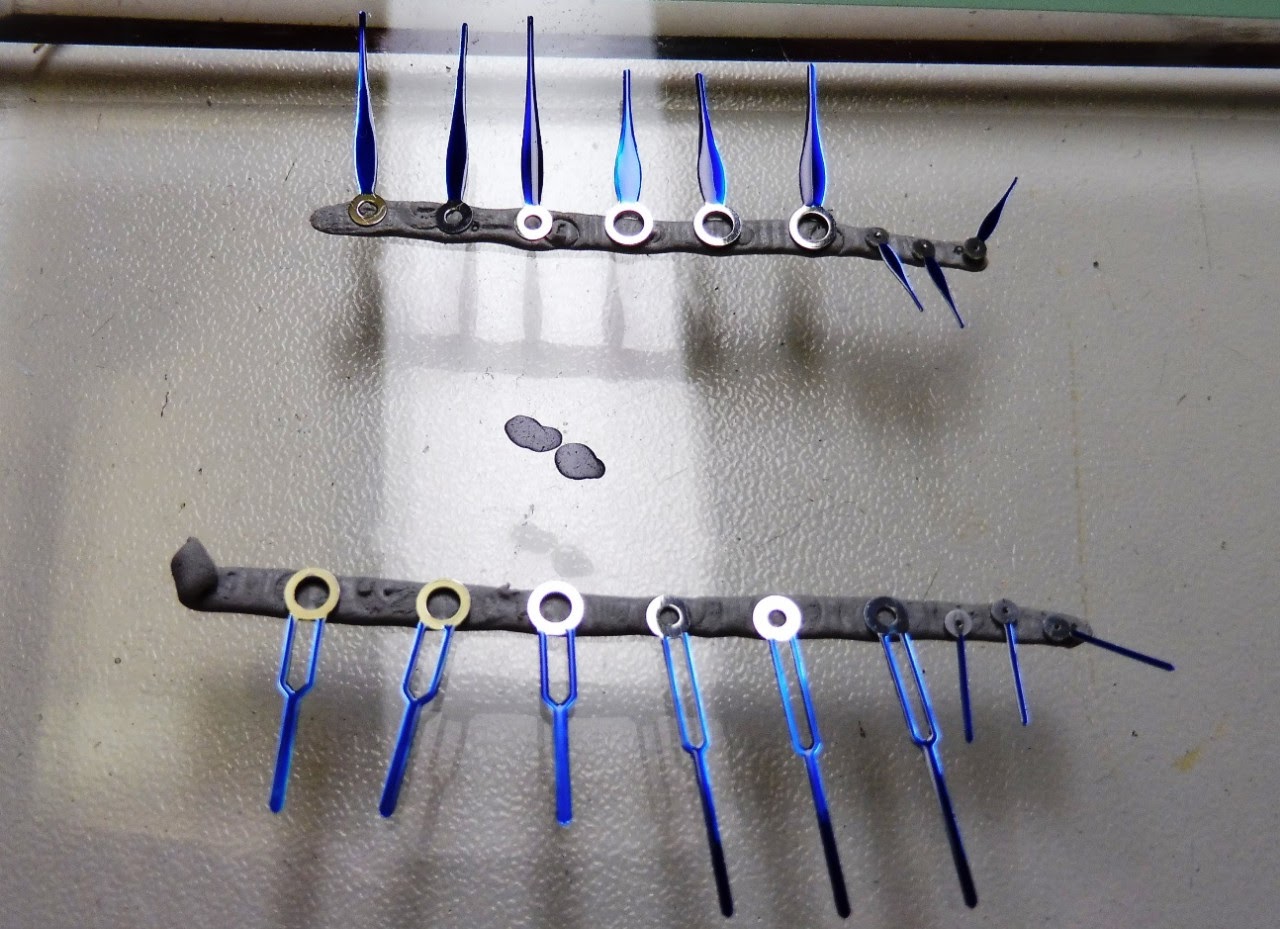
A close look at rhodium plated hands shows the huge
difference to the stamped ware you can buy from the industry catalogues. Hand
and shaft/tube of the seconds hand are milled as one part, providing a much sturdier
solution than riveted-on thin tubes. The heads are also milled slightly thicker
to avoid distortions when gripping them with the hand setting tool for removal.
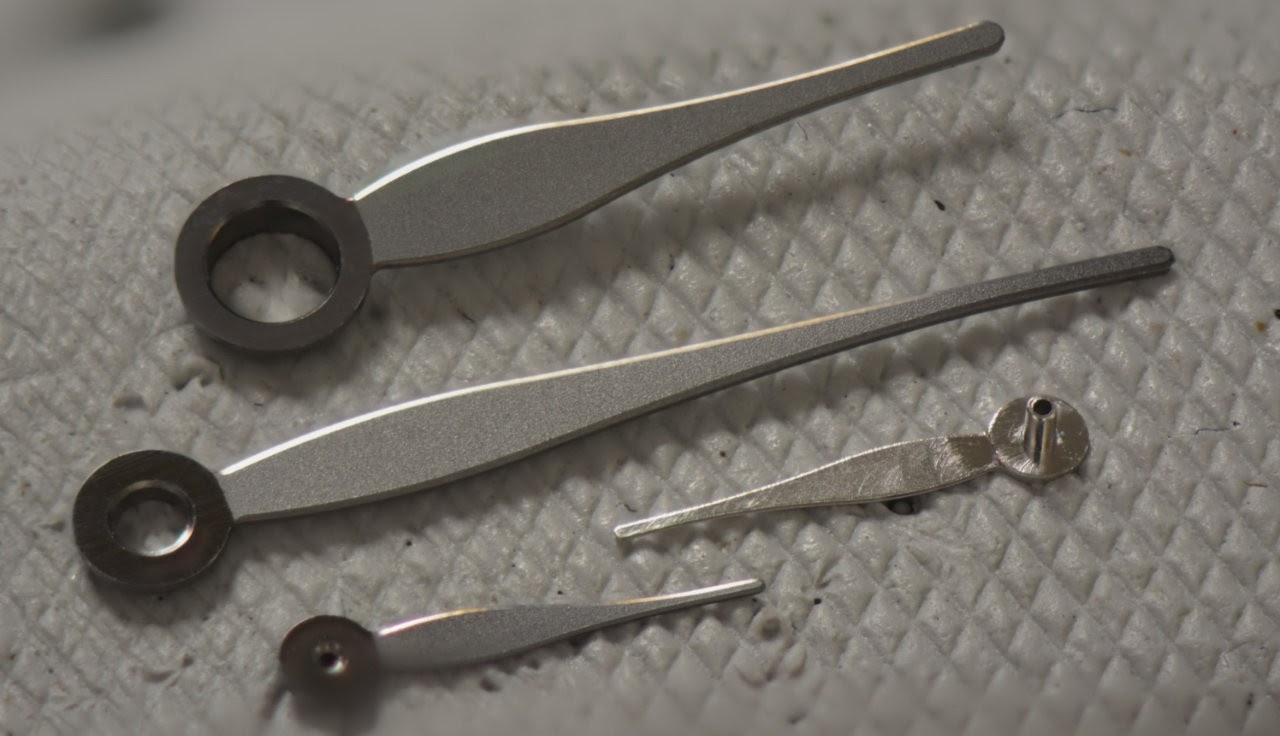
The dial engraving developed for the PuristS anniversary watch is an intertwined repetition of
the word “PuristS”, creating an Art Deco touch. The
same design principle is available with the script “Uhrenkurs”
or “WatchWorkshop”. I found the structure
respectively pattern created by the script in German more pleasing than the one
in English, likely because it appears denser and thus more uniform.
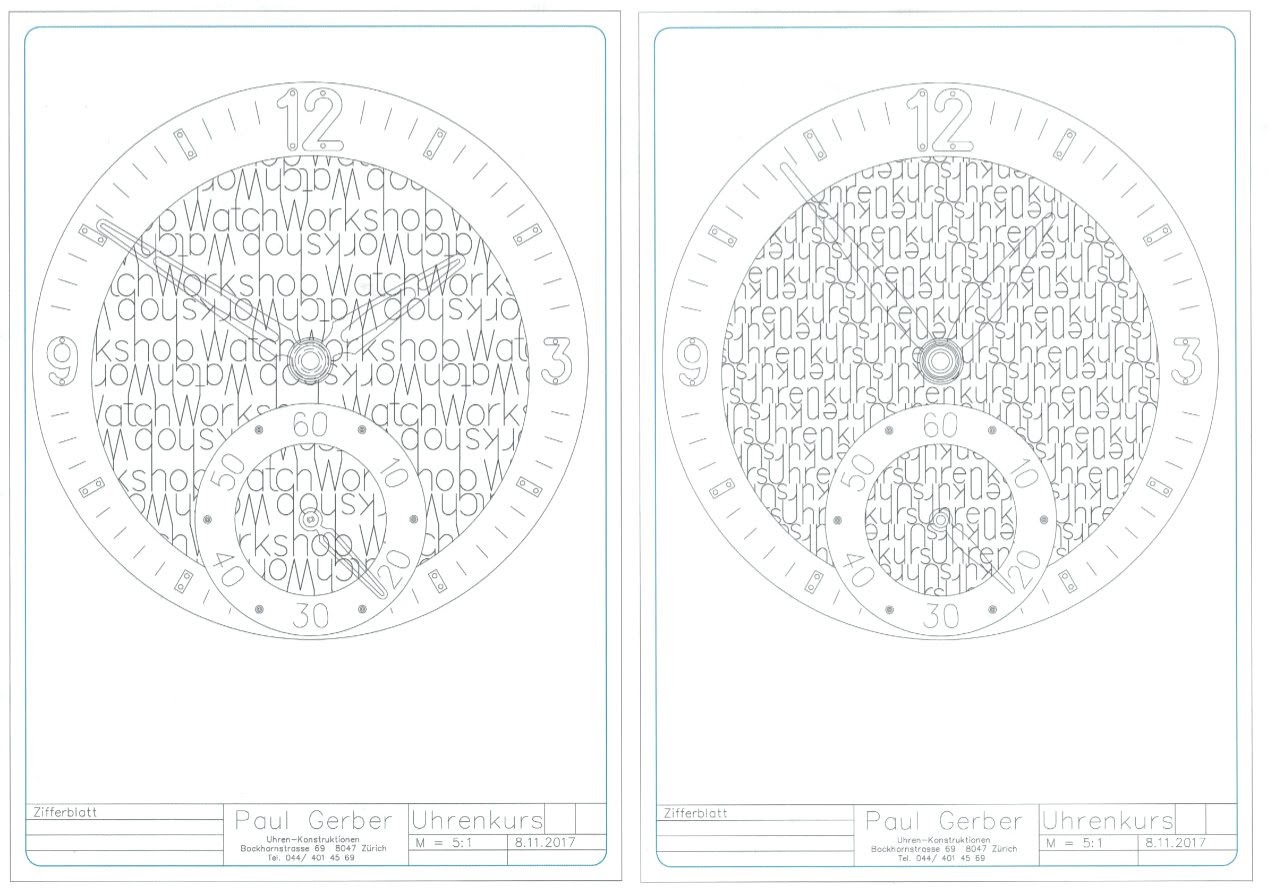
This dial engraving had an attractive sparkle when
looking at it in the artificial light of the atelier, but turned out to reflect
too much light in the blazing sun. For me, this “cheapens” the appearance of
the watch a bit, so some additional work might be necessary here with
hindsight.
By the way, the dial is not fixed with screws because
Paul Gerber hates the sore sight they usually create. Dial and case are
constructed to locate the dial firmly without the addition of screws.
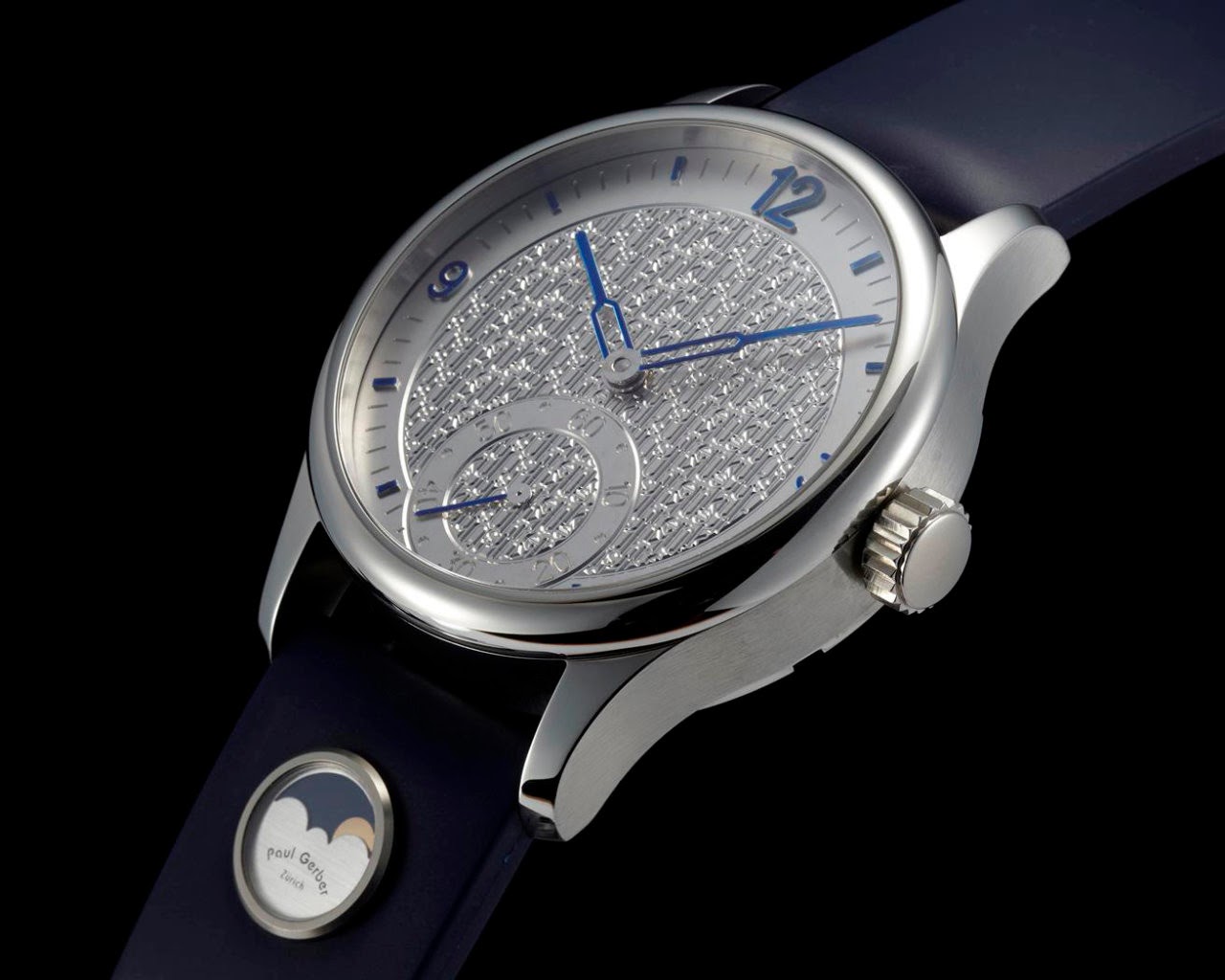
I am very pleased with the back view of the finished
watch too. With the rhodium plating of parts, the similarly coloured slots of
the blued screws do not look that much out of place as when judging them before
their mounting. The name plaque (on the photo for privacy a bit Photoshopped) is offered in a variety of styles by Paul
Gerber. I opted for the polished version with a “filled” name engraving. When I
asked what material has been used for the black “filling” (knowing how easily
this usually falls out of engravings), Paul Gerber surprised again with his
practical thinking: He mixes black laser printer powder with coloured Araldite
for a very durable paint; the plaque has only to be lightly polished over and
you get a crisp lettering filled to the brim of the engraving.
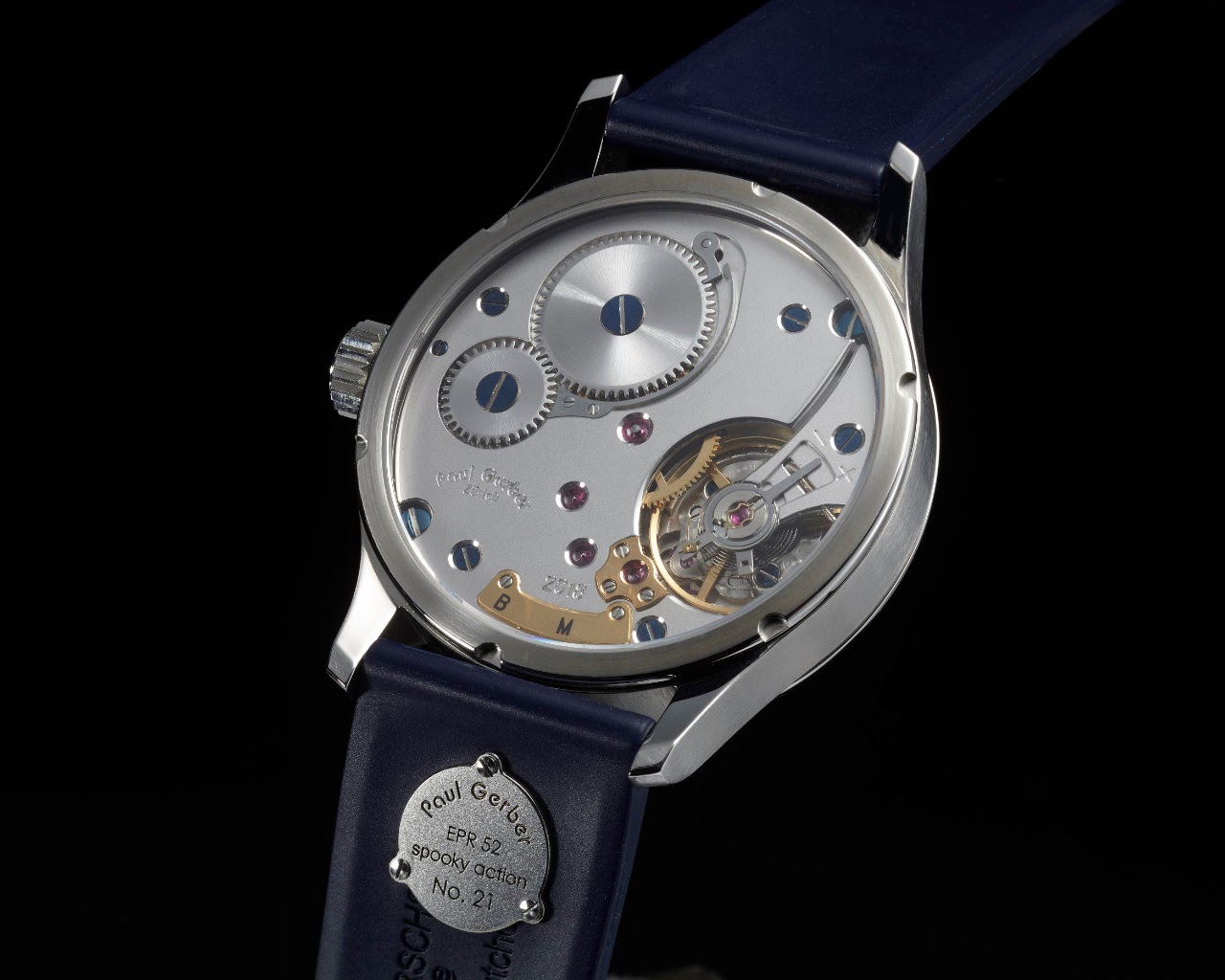
Paul Gerber’s own “Uhrenkurs”-watch
has the CNC-engraved small waves, a pattern he uses particularly on his dress
watches (Ref. 33). His watch is an older version of the course watch. He is constantly
improving details we also benefitted from.

My colleagues had chosen completely different dial and
hand combinations. With these features the watches look nice and elegant. It
just shows how biased I had become knowing the Purists’ edition, because this
bold design was for me representing THE Gerber style and I never considered
anything else.
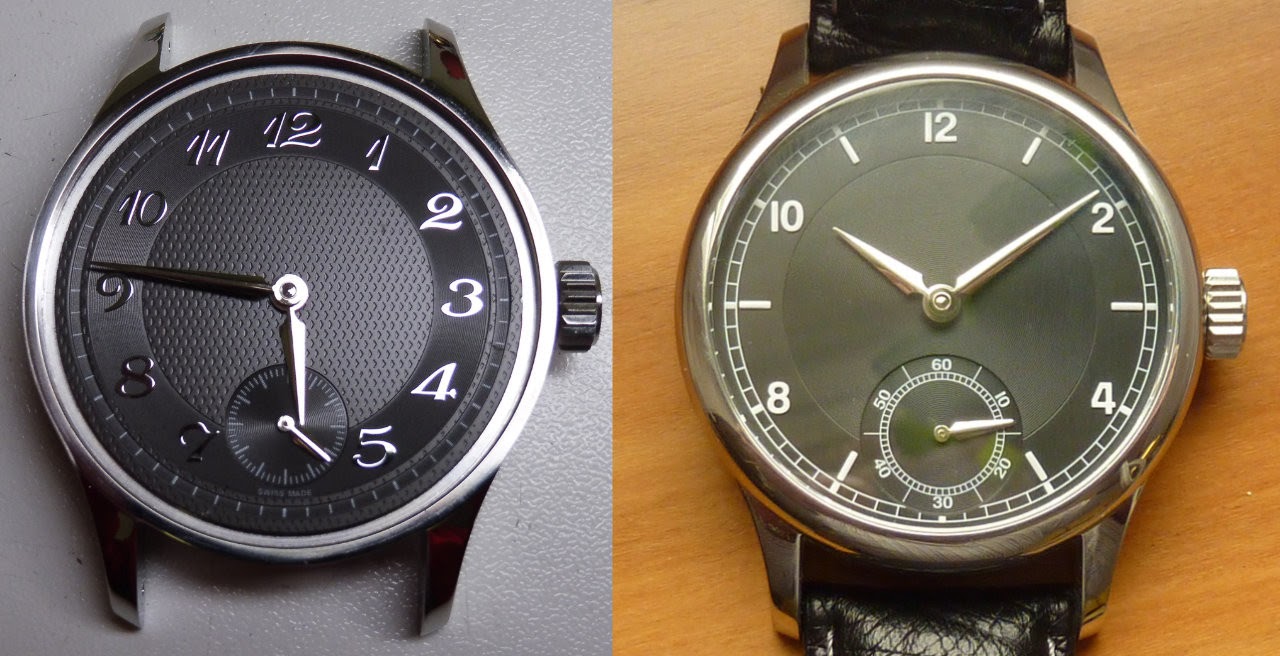
All three of us were keen to add the strap fitted moon
phase module of Paul Gerber. This standalone moon phase had its debut at Baselworld 2018. A customer with a MIH watch triggered the
development in 2016: He wanted a moon phase added to his watch, but the
construction of this watch (with calendar disks covering the whole under dial
area to the case edge) made it impossible to fit a traditional design. Thoughts
about showing the moon phases on the side (through the case) or on the back smelled
like too many compromises Paul Geber did not want to entertain. Living up to
his reputation as a master of the miniaturisation, he started the development
of his 52th calibre. The moon phase display is purely mechanical. It needed a
separate time source respectively movement. Since a mechanical solution with
spring-house and escapement had simply not enough space (the height was
critical if you want to fit this micro module into the strap in a
non-protruding manner), an electromagnetic drive with a modified Quartz
movement and a Renata micro battery (running around three years) had to be
created. All of it (54 parts excluding electronic parts) is in a waterproof Titanium
case (of seven machined parts made by Andreas Strehler’s
Uhrteil AG). Eventual corrections of the moon phase
display have to be done by the watchmaker when changing the battery; there is a
calculated one-day variation of the moon phase over a three-year period).

The photo below was made for the press. I was grateful
Paul Gerber was able to “retrieve” the already allocated number 21 for me. To
have “my” number on the watch was just the icing of a fantastic experience with
a watch that covers all my design tastes, what is also not a given when working
with parts supplied in a course.
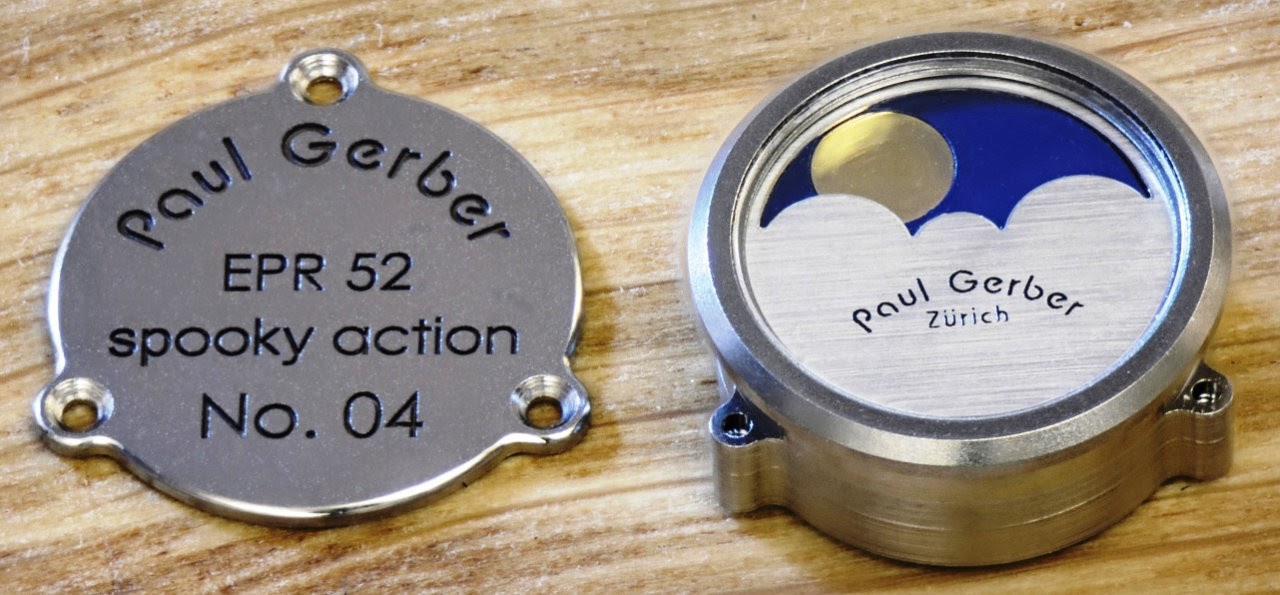
Concluding
Remarks
I enjoy having finally a Gerber watch in my collection
(but still hope to get one day my dream watch built by Paul Gerber as an
addition). Perhaps the dial has to be reworked slightly with a careful glass
bead blasting to reduce glare in bright sunlight. The bright “groves” of the dial’s
engravings reflect the light extremely well, crying for toning down the busy
decor a little bit.
With a case diameter of 42 mm (the movement filling it
to the edge) and a length (lug-to-lug) of 52 mm, the watch sits perfectly on my
19 cm circumference wrist. The watch is amazingly light, but still providing a
quality feel. The crown is of a size I like, just big enough to grab it easily
to wind or set the movement. In a way I am also surprised by the quality feel
when winding the watch. Paul Gerber’s modifications might help. Nevertheless, I
had many expensive watches in my hands that came not near this haptic pleasure.
Though, the watch as the material memento of three
days in Paul Gerber’s atelier is in any case just one part of the story.

Since quite a few years many authors preach about the
changes affecting the luxury industry, particularly a claimed reluctance of the
younger generations to spend money on „things“ and their desire to rather
invest in „experiences“. In a recent discussion (Dubai Watch Week London), a
panel guest defined “How can I get a unique experience?” as THE question
today’s watch buyer wants to have answered by the seller. Heeding such advice,
a diversity of offers has been created especially in the watch industry to get
closer to the end consumer as a brand and hopefully build up some loyalty for
further sales. Looking at these events, I get the impression most of the time
good intentions quickly degenerate into strictly organized mass offers. These
are no “experiences” for me; they simply provide another or additional form of
banal consumption, because a deep emotional component can hardly be part of the
deal, if there is not also a particular personal effort required from my side.
Like getting integrated into an organization or into tasks I am normally not
involved with, but now being asked to perform in this new environment nevertheless.
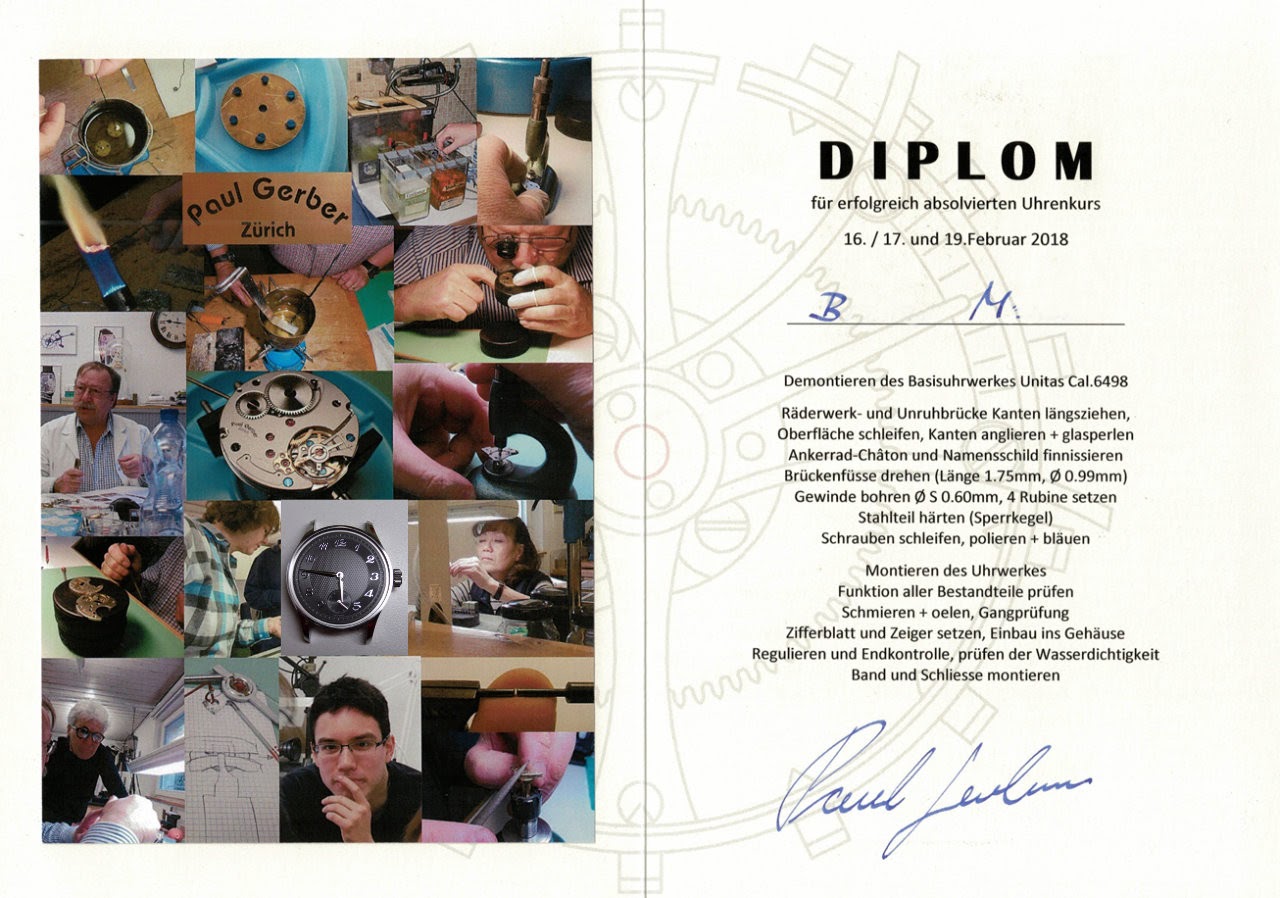
The participants of Paul Gerber’s watch course are not
clothed in the stereotypical white watchmaker’s coat, but we had to report to
work precisely at 08.30 h, and in the evening we could not leave the workplace
until the day’s planned jobs had been done. The coffee breaks in the morning
and the afternoon were short, with Ruth Gerber sending us back to the benches
when it would have been convenient to listen a bit longer to all the exciting
experiences Paul Gerber told us about.
To be treated like employees (with a lot of leniency
regarding expected work skills and speed…), working together and walking to a
local restaurant for a communal one hour lunch break, it felt quickly like to
be with good work colleagues. The discussions with Paul Gerber as “boss” were
for me as watch enthusiast also on a completely different quality and interest
level to what could be provided by professionally courteous marketing/sales
people.
On the other hand, I am a firm believer of the
proverb/advice “cobbler, stick to your last”. I would never enjoy the result of
my work, knowing that a specialist could have done better. Because I wanted to
take a nice Gerber-watch home with me after three days, I asked for help or
“subcontracted” the job on hand to the boss whenever I judged it too risky to
mess up in the last second (like fitting the hands or even fitting a
particularly tiny screw). I saw no point in building bragging rights to have
all done myself, and having to look at scratches when showing off the watch. But
I will also not frame the diploma to hang it on the wall of the office…
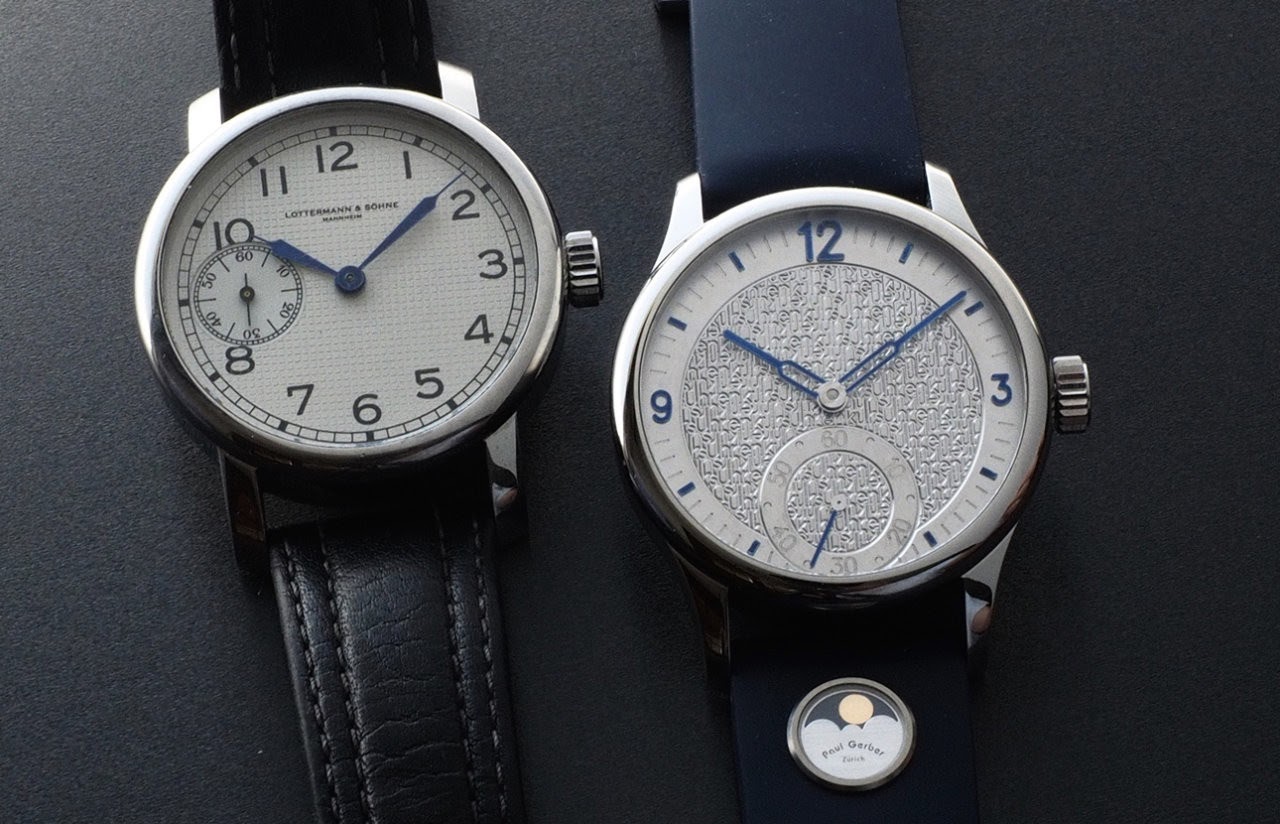
So, this course was for me truly a genuine experience,
with a corresponding value added to the watch. While work done with my own
hands was very educating and satisfying, it is not a prerequisite for an
emotional binding with the watch for me. Being intensively involved in the
creation and decision processes intellectually can be good enough. And for this
reason I enjoy working together with master watchmakers on commission pieces so
much. I believe that buying from an independent without savouring the
possibilities to bring you into the project to the fullest is giving away a
superb experience, providing life-long beautiful memories.
Björn
(Photos: Paul und Ruth Gerber, Jürg Meier)
This message has been edited by KMII on 2018-09-20 02:41:47





























































































